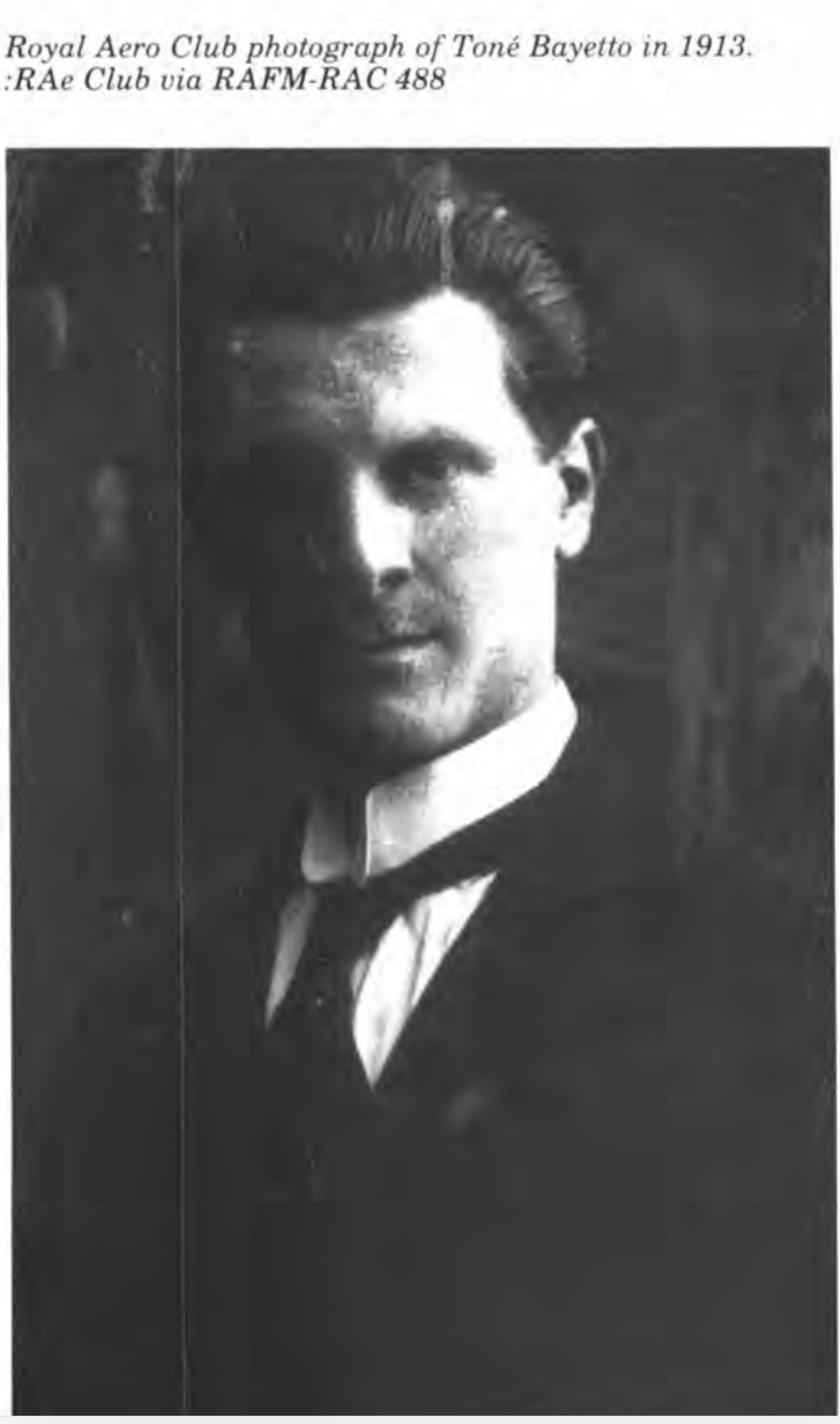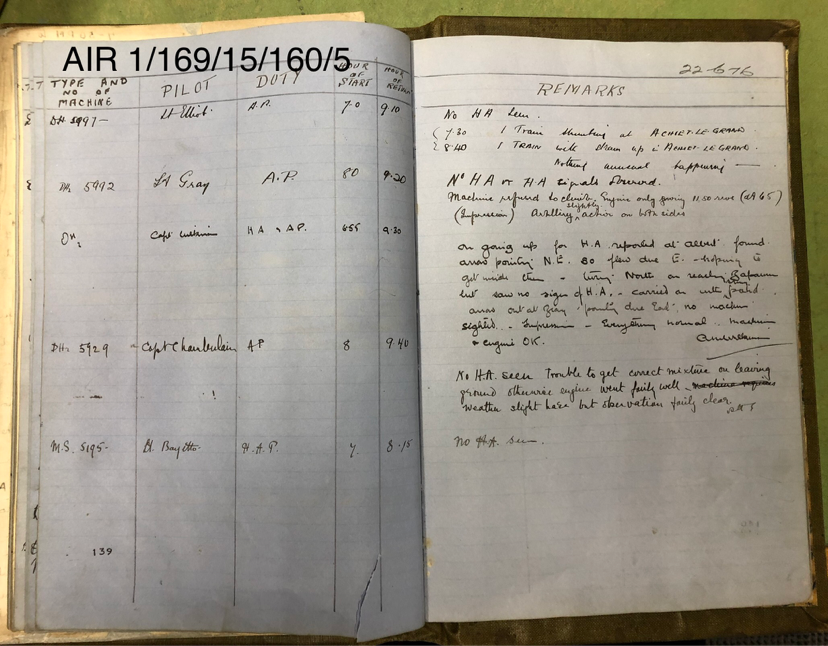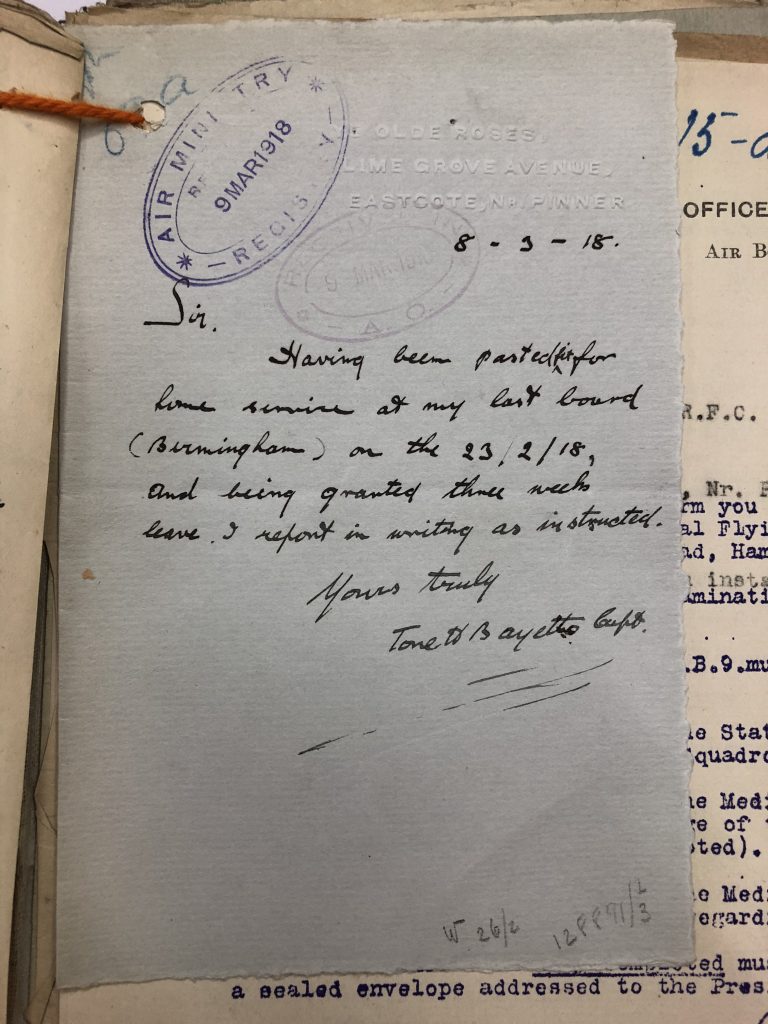Tone Hippolyte Paul Bayetto
Timeline of Tone & his family

Birth of Tone’s father
04.01.1864: Birth of Hippolyte Paul Bayettos in Torino, Piedmont, Italy to Dominique and Pia Carolina Bayettos
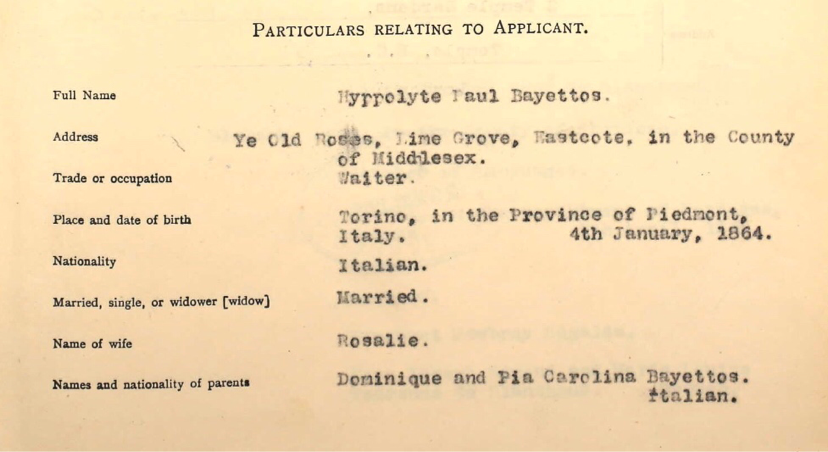
Birth of Tone’s mother
Birth of Rosalie Lemaire in Wauthier Braune Belgium
Rosalie’s move to England
Rosalie moved to from Wauthier, Braine, Belgium in order to keep her job working for a rich couple who had moved to England (info provided by a distant relative Denis Amerlynk).
Tone’s father Hippolyte moves to England
ref: HO144/1356/261608
Hippolyte & Rosalie marry
On 23 April 1889 Hippolyte and Rosalie marry at the Church of Notre Dame de France, Leicester Square, London (Rosalie Lemere , April – June 1889, volume:1a page: 963)
Death of infant Claude Rosi
Tone’s older sister Claude Rosi Bayetto was born in 1989 (Q3 Brentford 3a 96) and died a few months later (Q1 1990 St Saviour 1d 96)
Birth of Tone’s brother
Birth of Tone’s older brother Claudio Joseph Bayetto, (Q2 189, St Giles, Vol.1b p.681)
Birth of Hippolyte Dominique Bayetto (AKA Tone Hippolyte Bayetto)
Birth of Hippolyte Dominique Bayetto at the French Hospital, Shaftsbury Avenue, London. St Giles LONDON (Q2 1892, vol 1b, page 638).
[1] Several sources incorrectly state that Tone’s was born at 7 Finborough Rd London SW10 but this was his address at the time of gaining his flying licence (see entry for 22 May 1913). These sources include: Finborough Theatre Local History, Cross & Cockade Int. 1995, 26 (4):191-196.
[2] His father’s naturalisation papers (HO144/1356/261608) record his date of birth as 2 May 1892.
Tone Attends French School in Westminster
Around this time Toné will have attended the French Protestant church School of Westminster. https://www.ucl.ac.uk/bloomsbury-project/institutions/french_protestant_church_school.htm
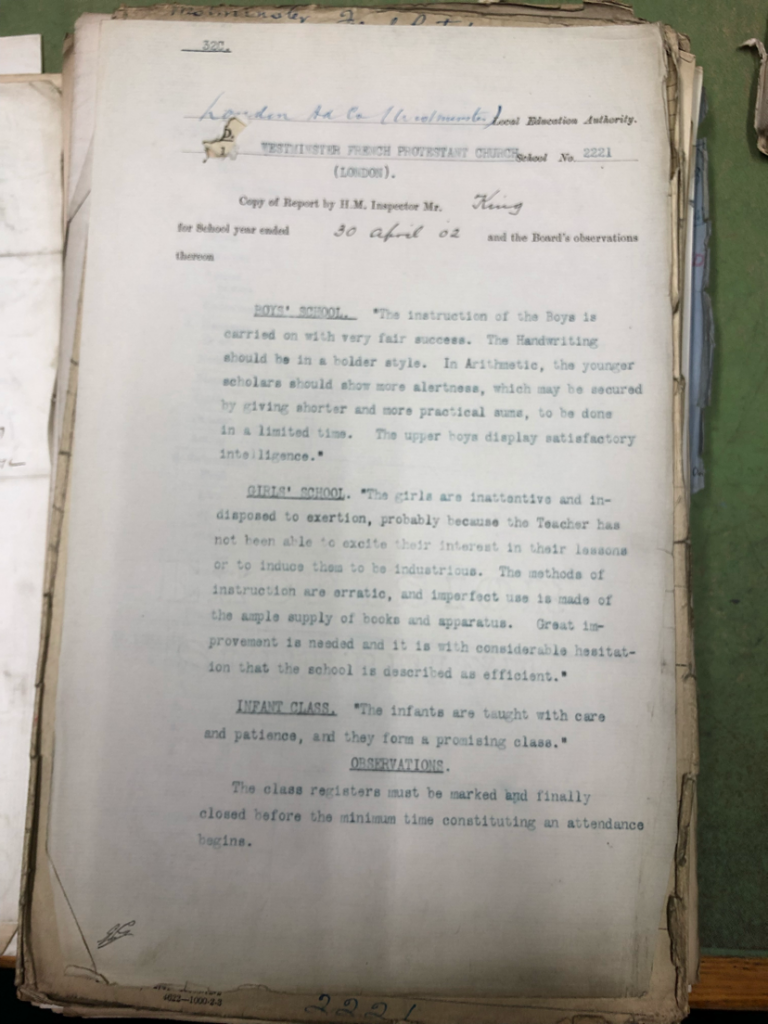
Tone Starts School at St Martins in the Field
Tone and his older brother Claudio both start school at St Martin-in-the-fields School on 6 February 1900. For both boys: “Last School: French School….. Reason for leaving: Belgium”
At that time they were living at 257 Sandringham Flats, Charing Cross Road, London – in the St Giles district. 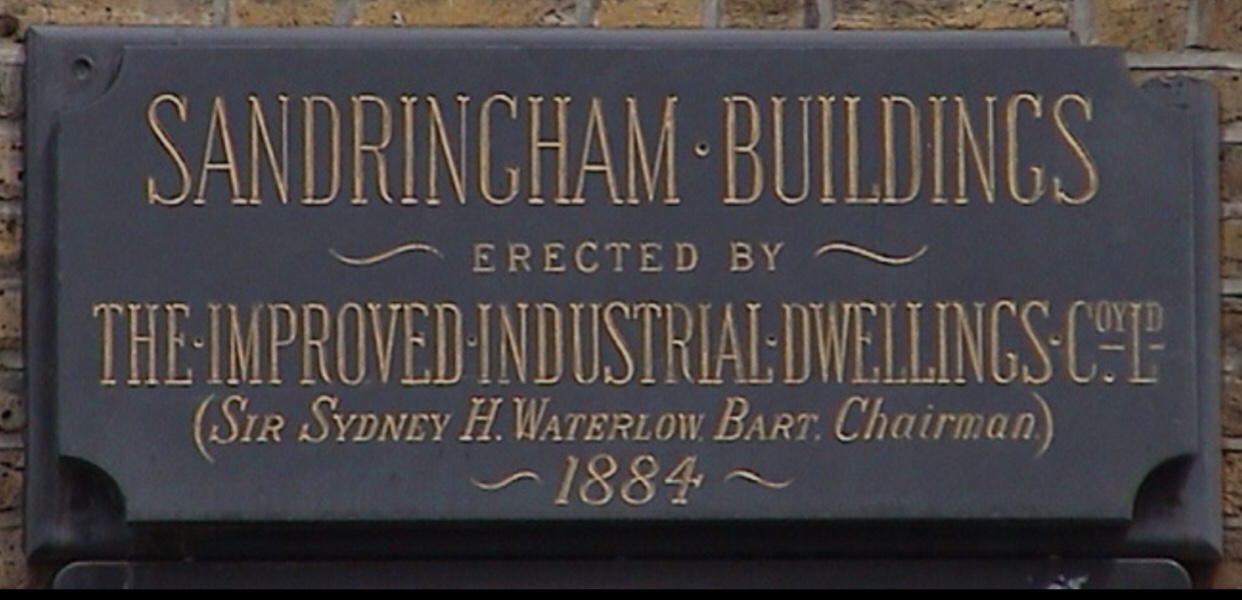
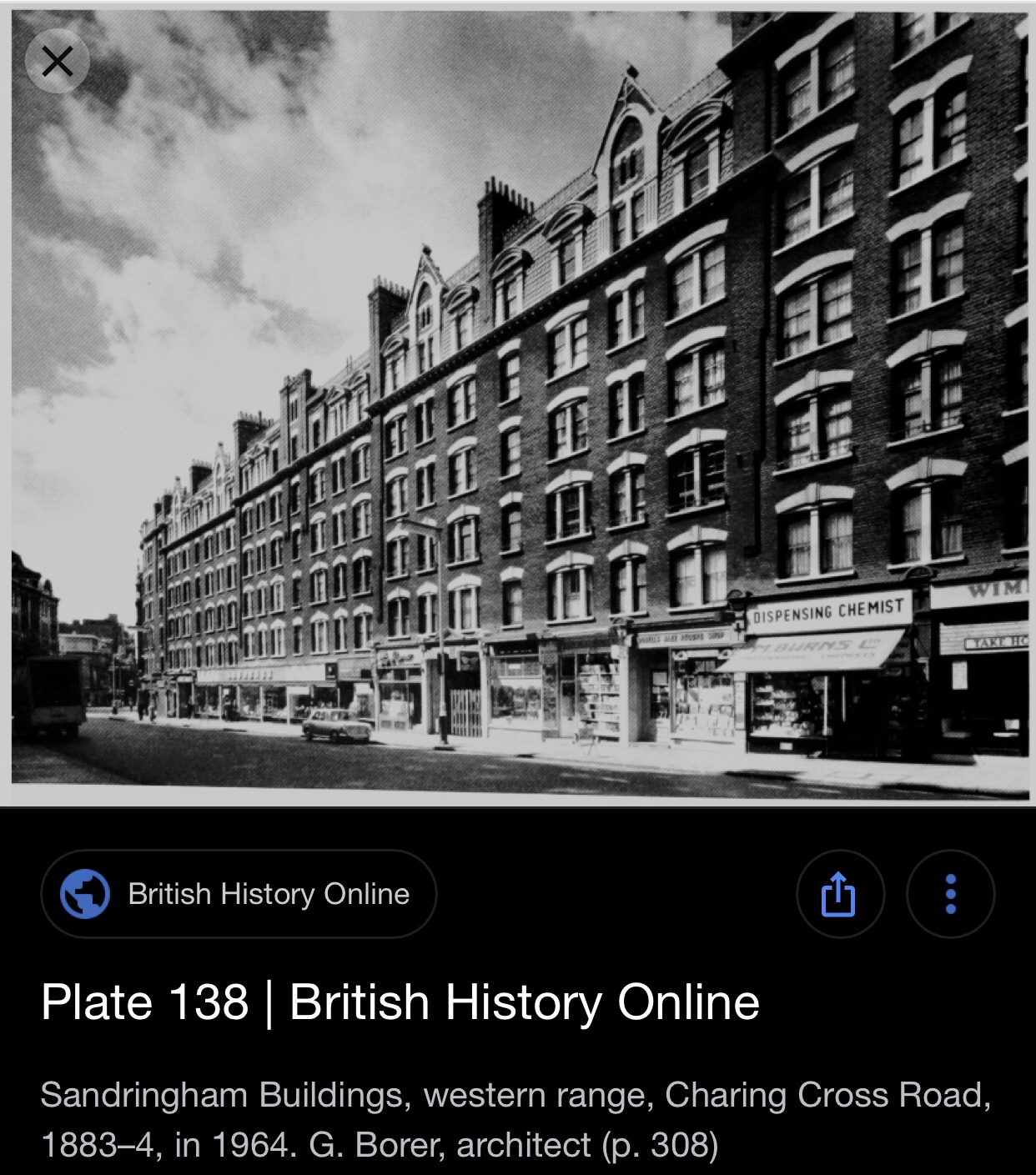

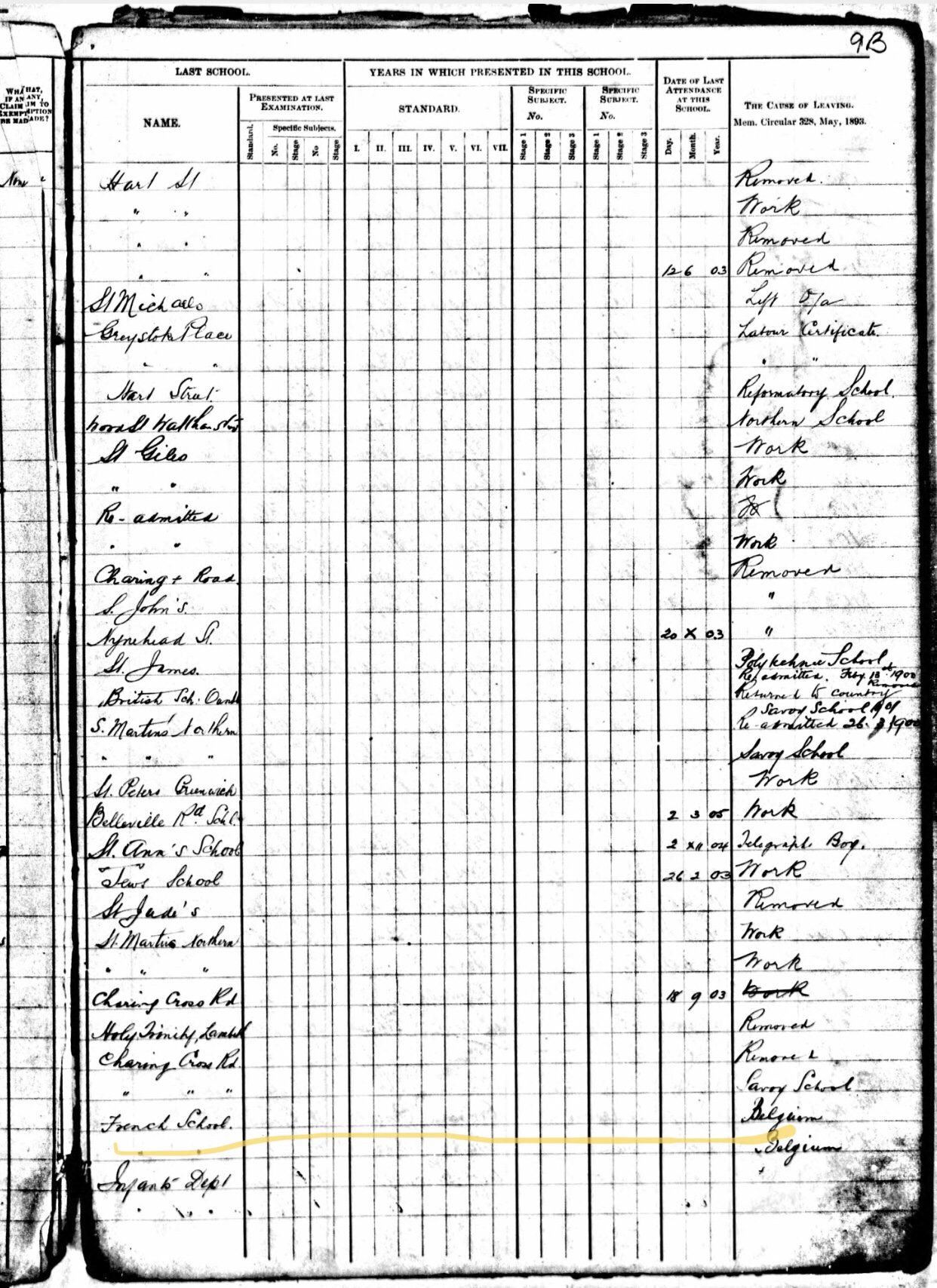
1901 Census
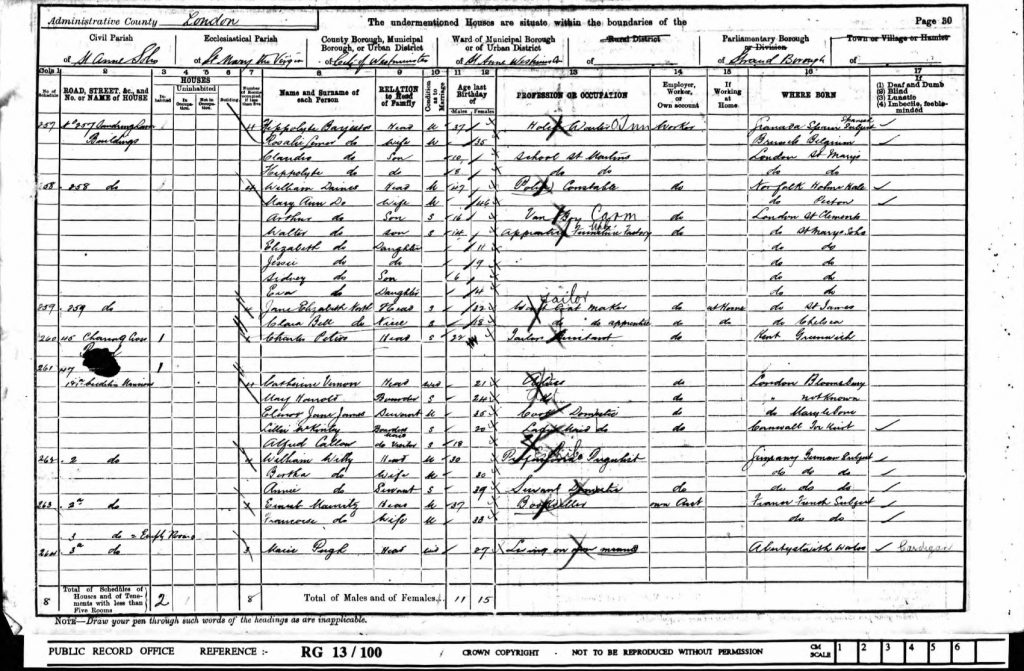
Hippolyte is incorrectly recorded as having been born in Granada, Spain (Spanish subject).
The Bayettos moves to 143 Hambalt Rd, Clapham Common
The Bayettos purchased 143 Hambalt Road, Clapham Common, London and lived there till 31 August 1909 [HO 144/1356/261608]

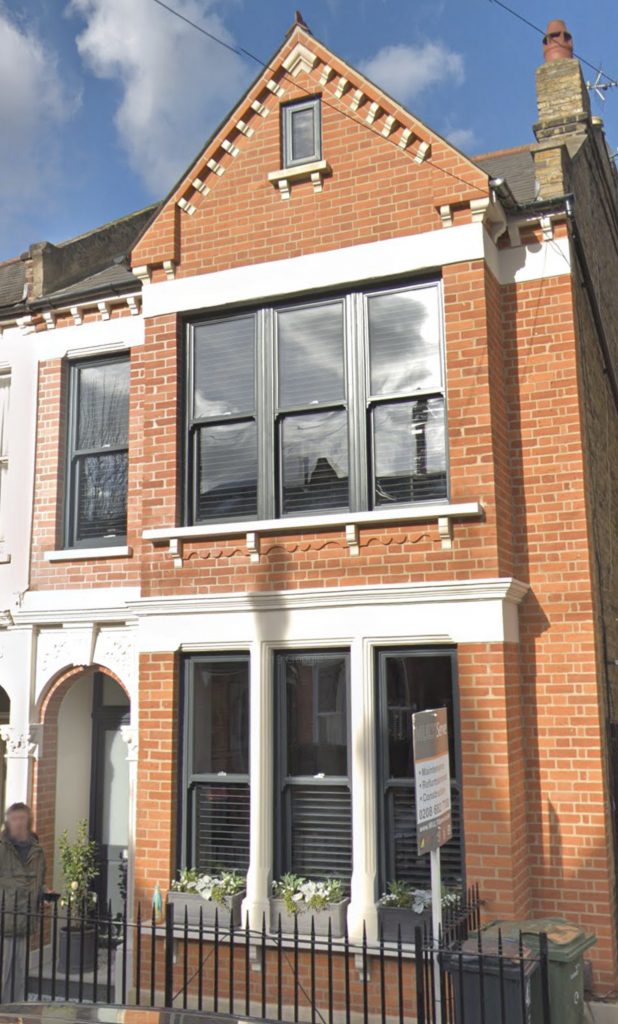
Bleriot’s Cross Channel Flight
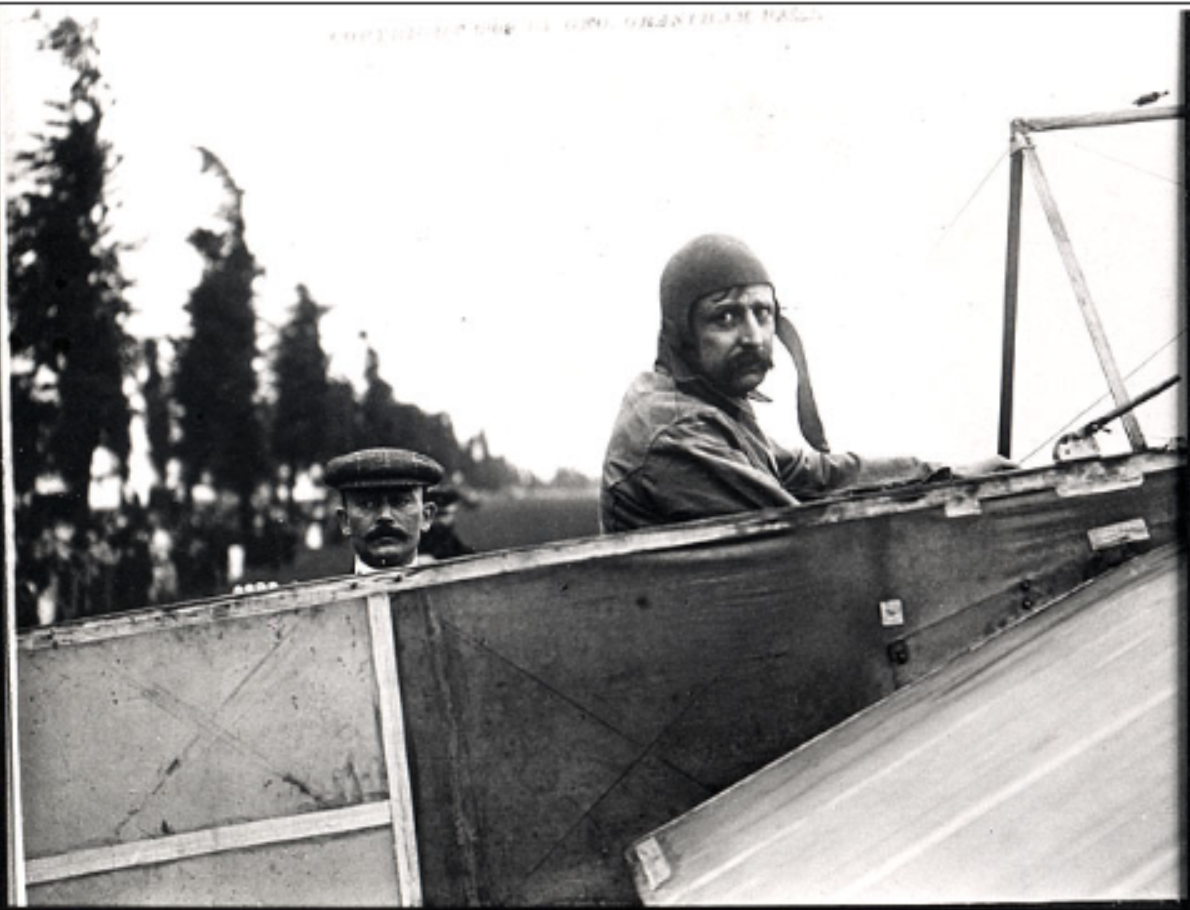
Louis Blériot sitting in his Bleriot XI at the start of his cross-Channel flight of 25 July 1909. NASM-2B02568, Smithsonian National Air and Space Museum Archives
Early in the morning of July 25th, 1909 Louis Blériot (1872-1936) crossed the English Channel, a distance of 22 statute miles (36.6 km) from Les Barraques (near Calais) to Dover. There had been longer flights and further flights, but the conque st of the Channel by air was a sensation and brought Blériot instant fame. Blériot had been a successful manufacturer of automobile headlamps who became fascinated by aeronautics in starting in 1901. He brought his latest aircraft to Les Barraques, the Type XI, a little monoplane fitted with a 25-horsepower, 3 cylinder Anzani motor. The London Daily Mail had put up a £1,000 prize for the first airplane flight across the Channel, and Blériot was competing with two other aviators, Hubert Latham and Charles de Lambert. Lambert, who received his training from Wilbur Wright, had been injured in a test flight and was out of the running. Latham had already attempted a Channel flight – he had made it halfway across the Channel in his Antoinette IV monoplane on July 19 when engine failure brought him down in a forced landing in the sea. On the morning of the 25th, Latham was ready for another attempt with a replacement aircraft, but was still fast asleep when Blériot took to the air. The flight took 36 minutes, 30 seconds, and was not without suspense. Blériot had also been injured in a test flight and was in pain with a badly injured foot. The photograph above, taken just before the flight, shows the strain that Blériot was under. It began to rain, and Blériot feared that the moisture would cause the Anzani to pack it in. The weather became turbulent, and visibility declined; he later recalled thinking – I am alone. I can see nothing at all. At Dover, the wind nearly caused him to crash, and his landing gear and propeller were damaged. But he had made it, and he was declared the winner. It was the first successful flight by an airplane over a large body of water. Hubert Latham was not happy when he finally woke up. Blériot became a hero, celebrated on both sides of the Channel. And his Type XI became a best seller – many were produced by the Blériot firm, others by foreign licensees. [ https://airandspace.si.edu/stories/editorial/bl%C3%A9riots-cross-channel-flight ]
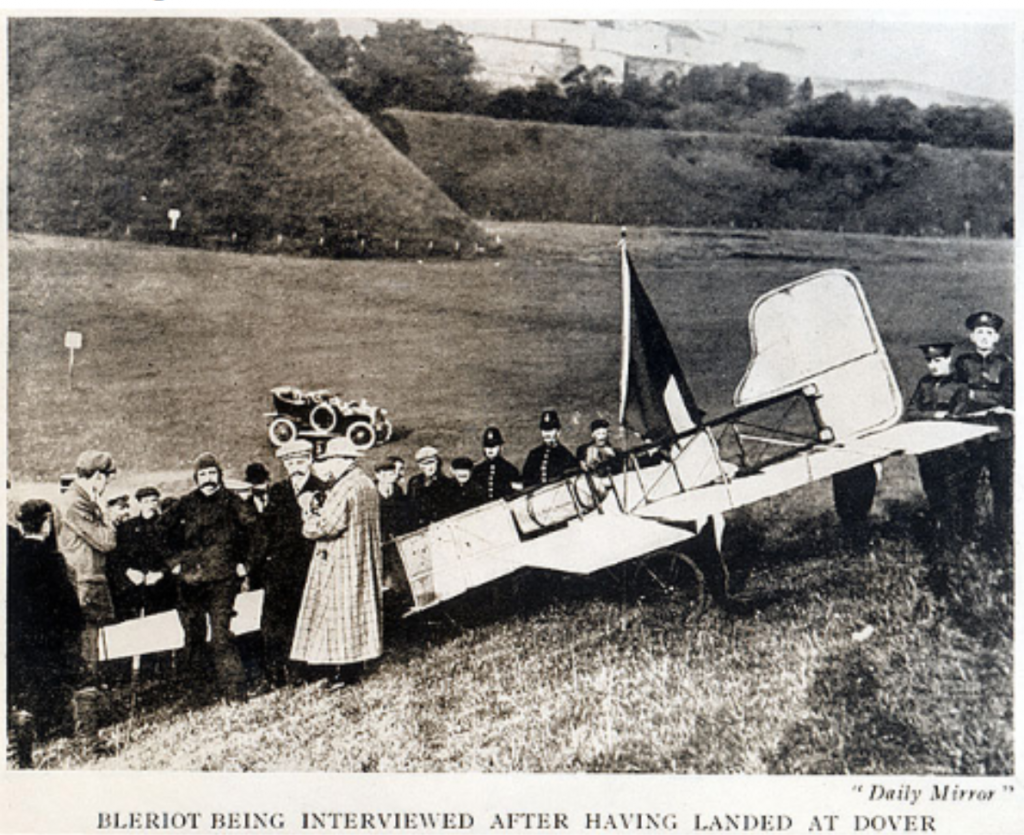
The Bayettos move to 26 Sumburgh Rd, Clapham Common
The Bayettos purchased 26 Sumburgh Road, Clapham Common, London and lived there till 16 May 1913. [HO 144/1356/261608]
Tone works as a Racing Driver
Tone records his occupation as a racing driver for Fiat Motors in Wembley from 1910 to 1911 (AIR/76/29)
Tone Travels to India
Hippolyte (Tone) sets off from London to Bombay on board the SS Arabia. His service record card (AIR/76/29) states that he was working for the Bombay Motor Car Company in Bombay, India as a motor engineer from 1912 to 1913 (but probably should have been 1911 to 1912).
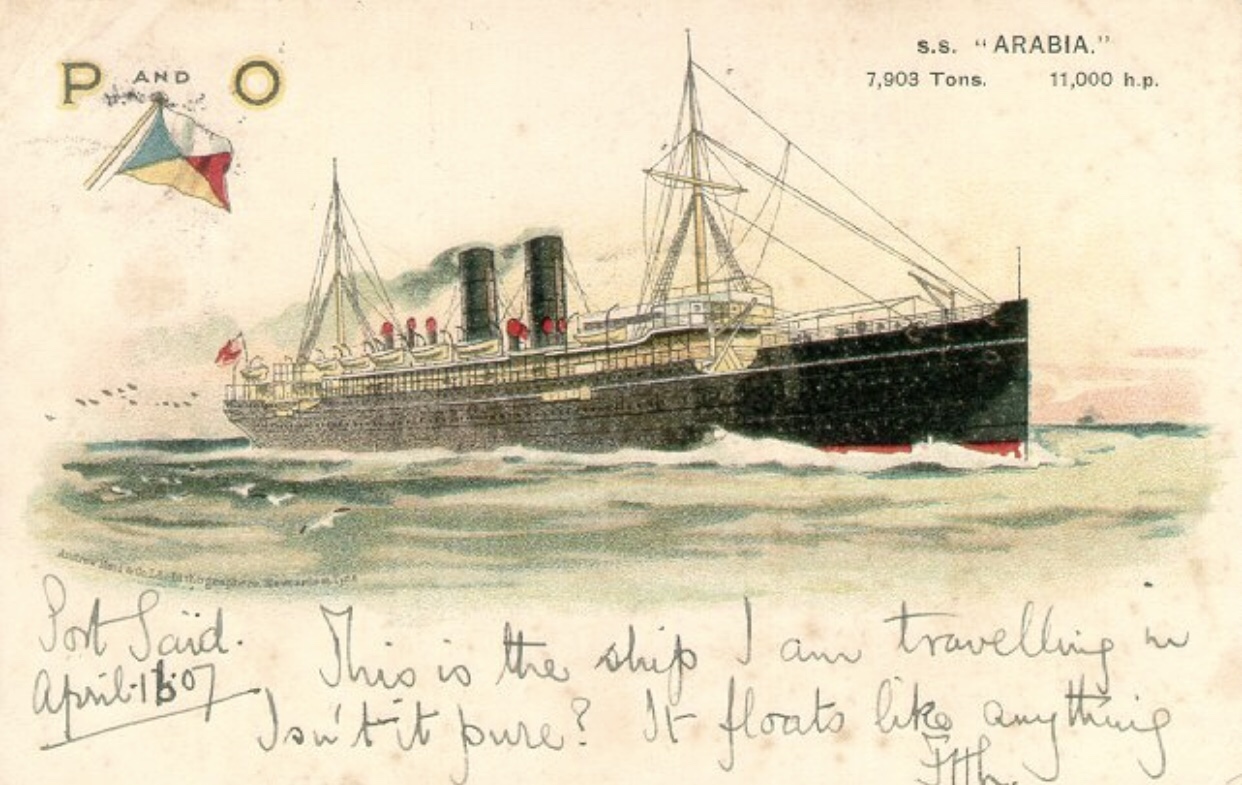
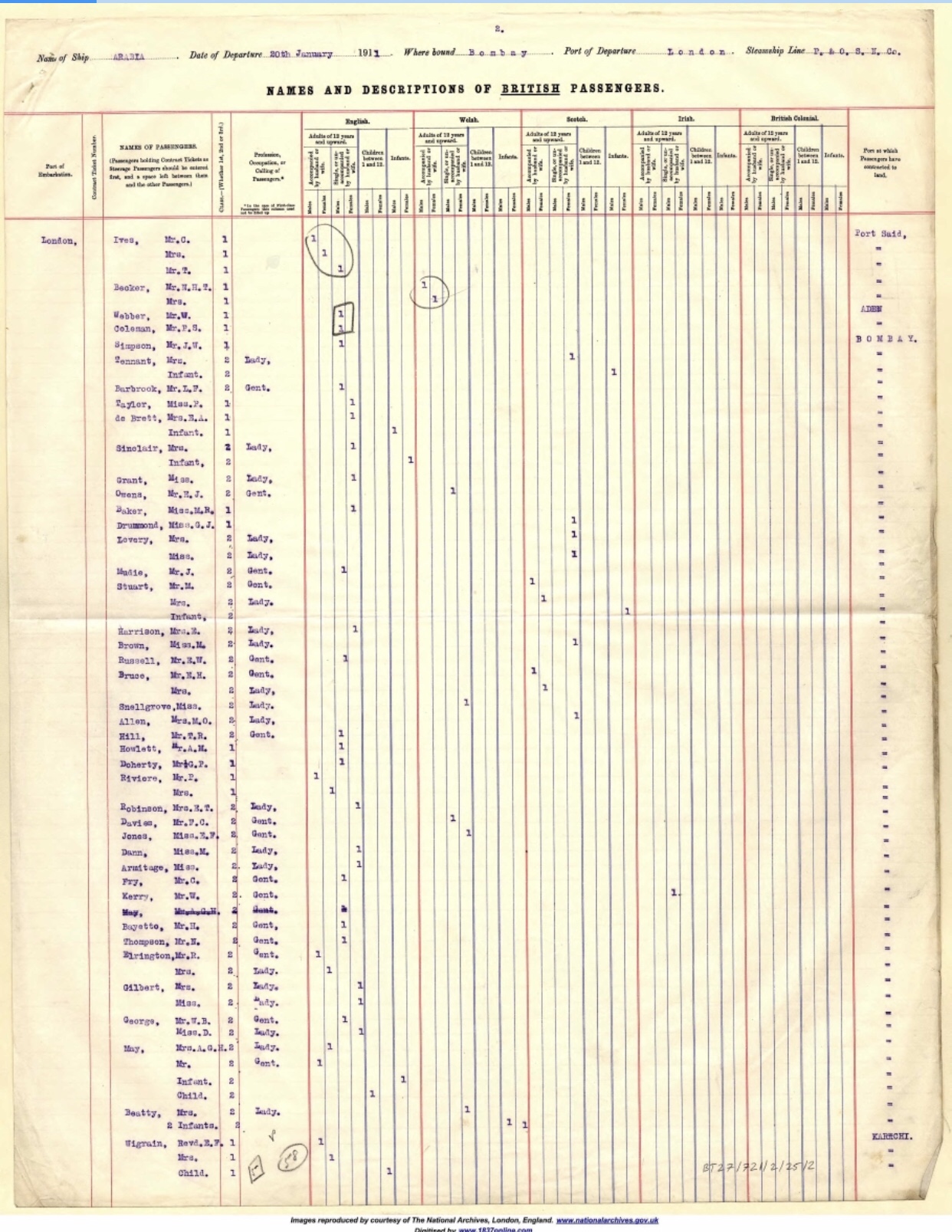
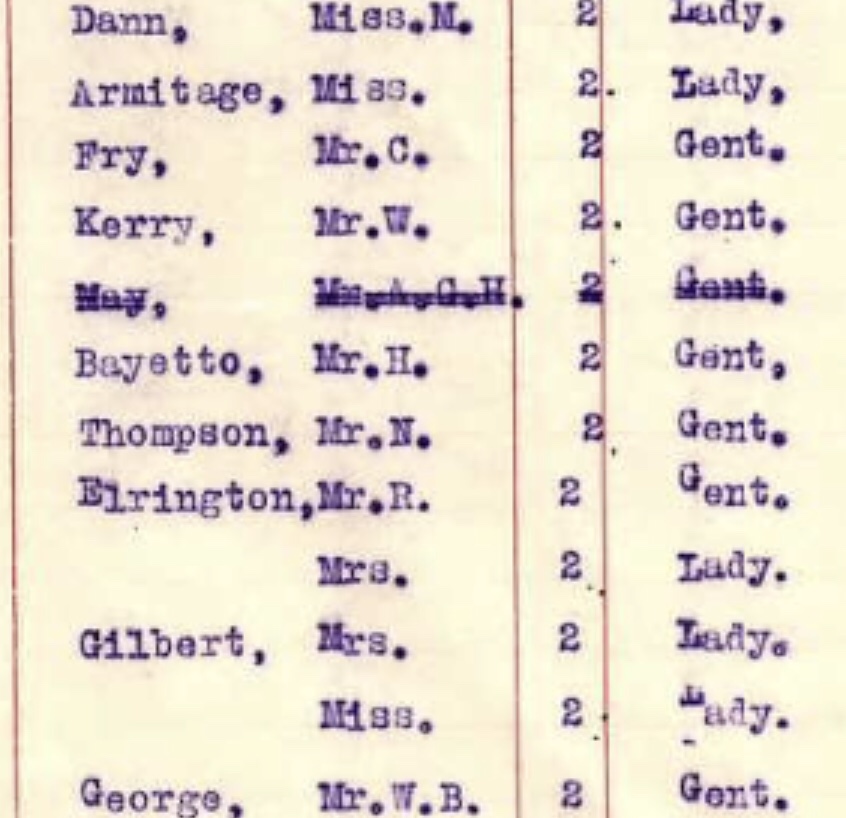
1911 Census
Bayetto household during the 1911 Census. Tone’s parents Hippolyte (restaurant waiter) & Rosalie plus his older brother Claudio (motor mechanic, repair works) were living at ‘Sandringham’ 26 Sumburgh Road, Clapham Common, West Side, London. Tone was presumably visiting Bombay at the time of the census. Hippolyte’s nationality (Italian) is correctly recorded this time.


Tone starts flight training in Hendon
Tone is a new pupil at the Grahame White School, London Aerodrome, Colindale Avenue, Hendon, learning to fly at his own expense.
“Instructed by Mr Lewis Turner in controls previous to rolling on 25-hp Blériot.” [Flight, No.195, Sept 21 1912]
Teaching-Flying_Flight_International_Magazine_1913-03-22-pdfThe Bayettos Move to Fulham
The Bayettos lived at 7 Finborough Road, Fulham, London until 25 October 1913 (while their new house in Eastcote was being built). [HO 144/1356/261608].
Royal Aero Club Aviator’s Certificate 488
Tone was awarded Royal Aero Club Aviator’s Certificate on 22/5/1913, aged 20y at
Tone having learned to fly in a Blériot at his own expense at the Grahame White School Hendon was awarded Royal Aero Club Aviator’s Certificate on 22/5/1913, aged 20y. In order to enter the RFC as a pilot it was initially a requirement that the applicant acquire a Royal Aero Club aviators certificate at their own expense. If accepted into the RFC a nominal 75 pounds would be refunded. This requirement was dropped in July 1916, although an individual could still apply for an RAeC ‘ticket’. The plane he learned to fly on had gained immortality on July 25, 1909 when Louis Blériot successfully crossed the English Channel from Calais to Dover in 36.5 minutes.
“Mr. Tone Bayetto (Tuesday), on No. 2 Bleriot, starting his brevet tests, but being compelled to come down owing to engine trouble. School started work 5.13 Thursday…. Mr Tone Bayetto doing circuits. Later starting brevet tests and gaining his certificate in fine style.”[Flight: MAY 31, 1913. p593]
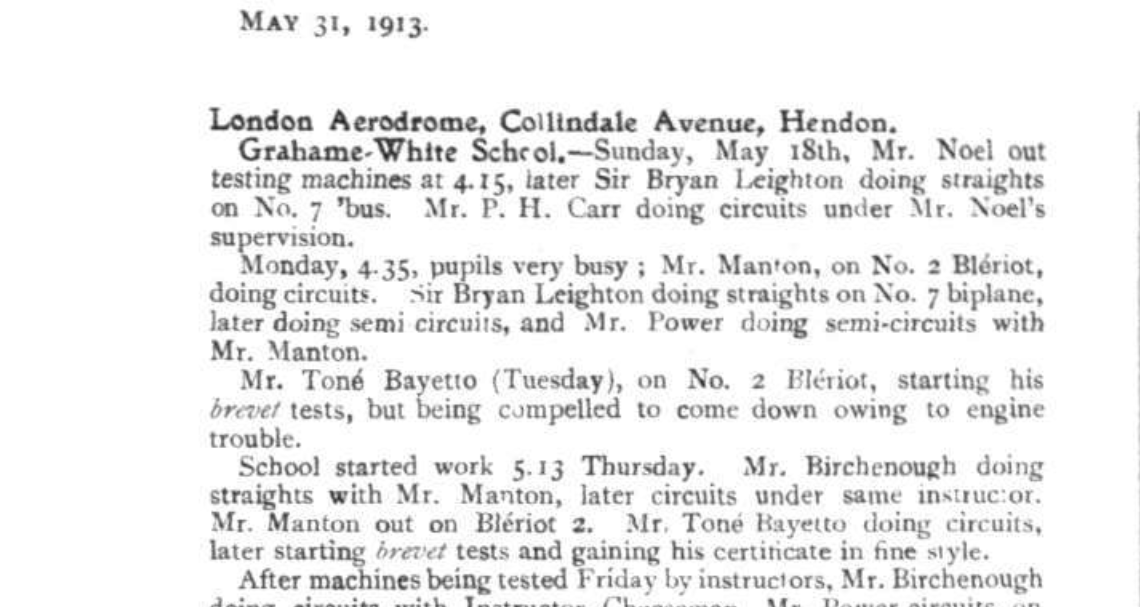
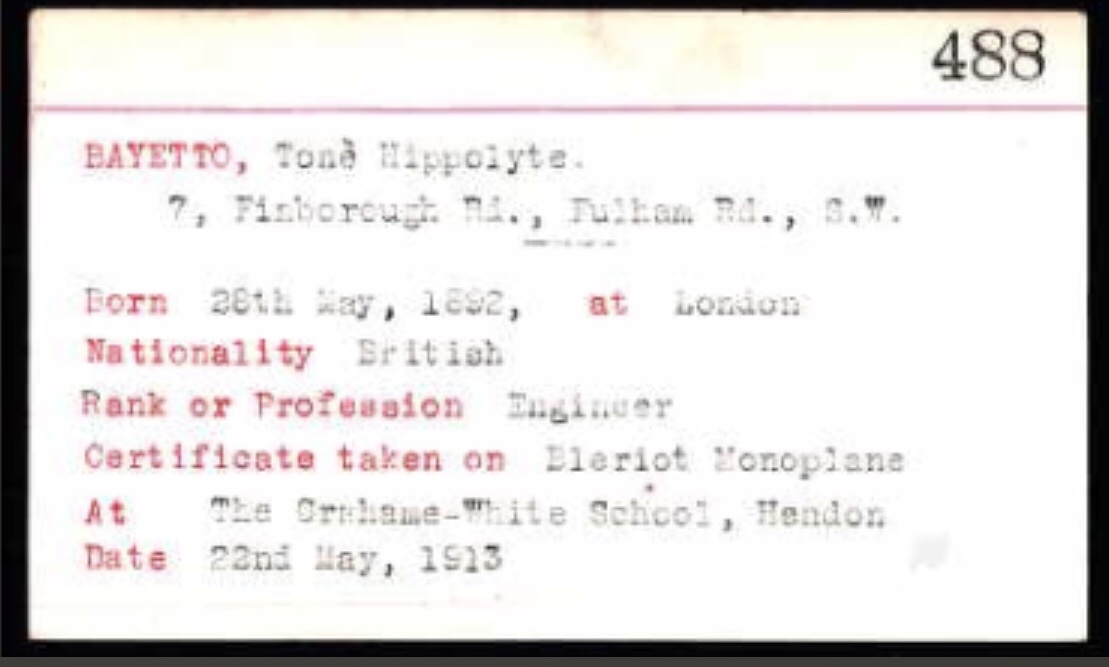


The Bleriot gained immortality on July 25, 1909 when Louis Blériot crossed the English Channel from Calais to Dover in 36.5 minutes.
Tone Continues Flying at WH Ewen School, Hendon
Regular fortnightly commentaries from the Aerodromes in Flight magazine show that Tone continues with regular flying training/practice at London Aerodrome but with the WH Ewen School, (Flight; 28 June 1913: p703) and the final record of him doing this is mid September 1913 (Flight; 27 Sept 1913: p1074) https://www.gracesguide.co.uk/William_Hugh_Ewen
Bayettos start building a house on their freehold plot in Eastcote
24 July 1913 is the date on the cornerstone of the Bayettos new family home, Ye Olde Roses, Lime Grove, Eastcote, Pinner, in the village of Eastcote.
With the extension, from Harrow to Uxbridge, of the Metropolitan Railway, and the opening of Eastcote Halt in 1906 in the locality formerly known as Field End and a station in 1910, Eastcote suddenly became accessible and developers saw the potential of Eastcote. Field End House farmland was sold to the British Freehold Investments Syndicate in 1909 and they laid out a network of roads, recognisable by the use of trees names for their roads. Plots were sold for building individually or in groups at public sales. £3 down could secure any plot and the balance could be paid off at 10 shillings a month. In a few months 650 plots were sold at an average price of £50. The first houses appeared in Elm Avenue, Lime Grove, Myrtle and Acacia Avenues. The Old Roses was the second house built in Lime Grove and was designed by Architect Frank Osler.
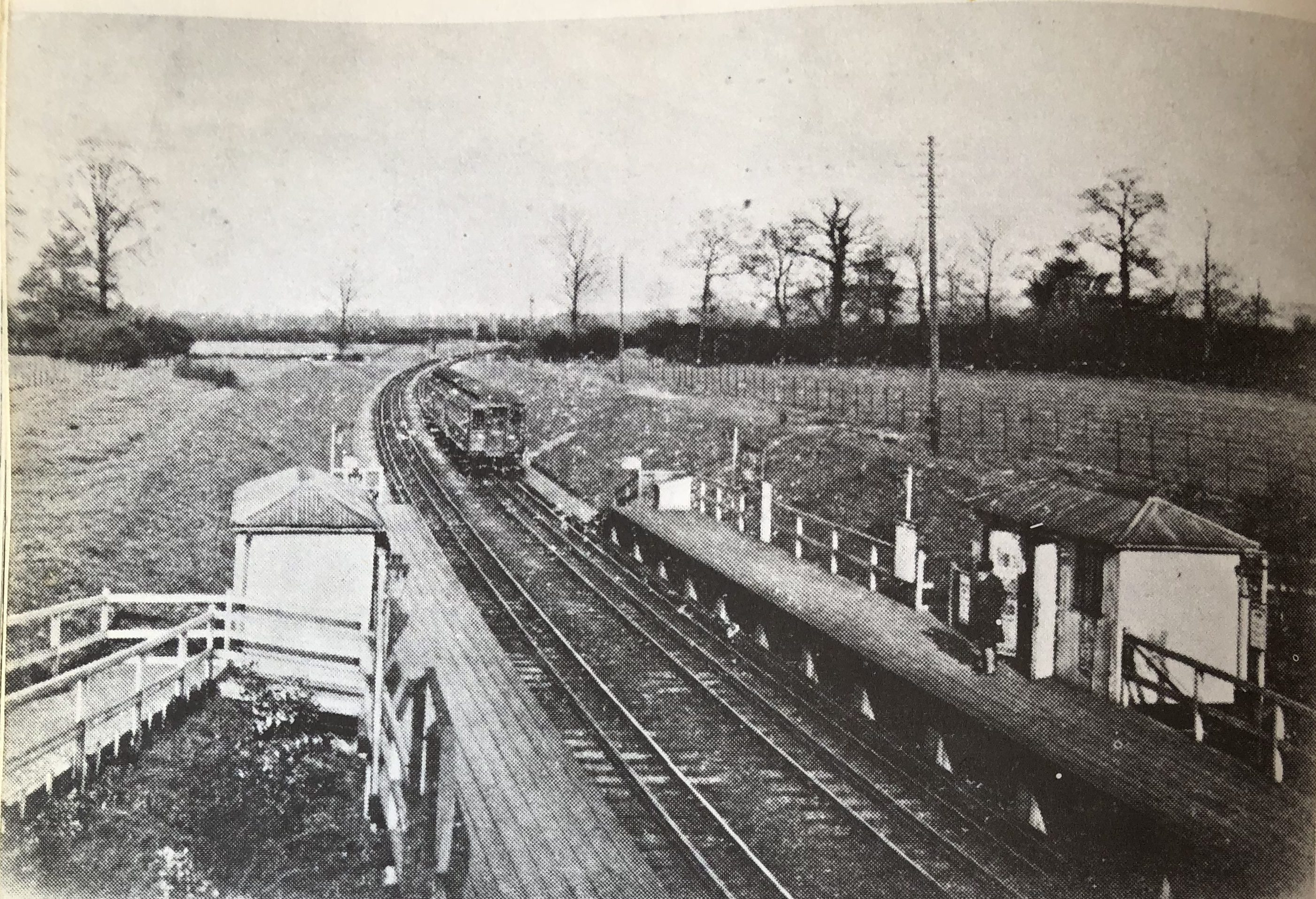
Eastcote halt in 1909 
Eastcote halt in 1934 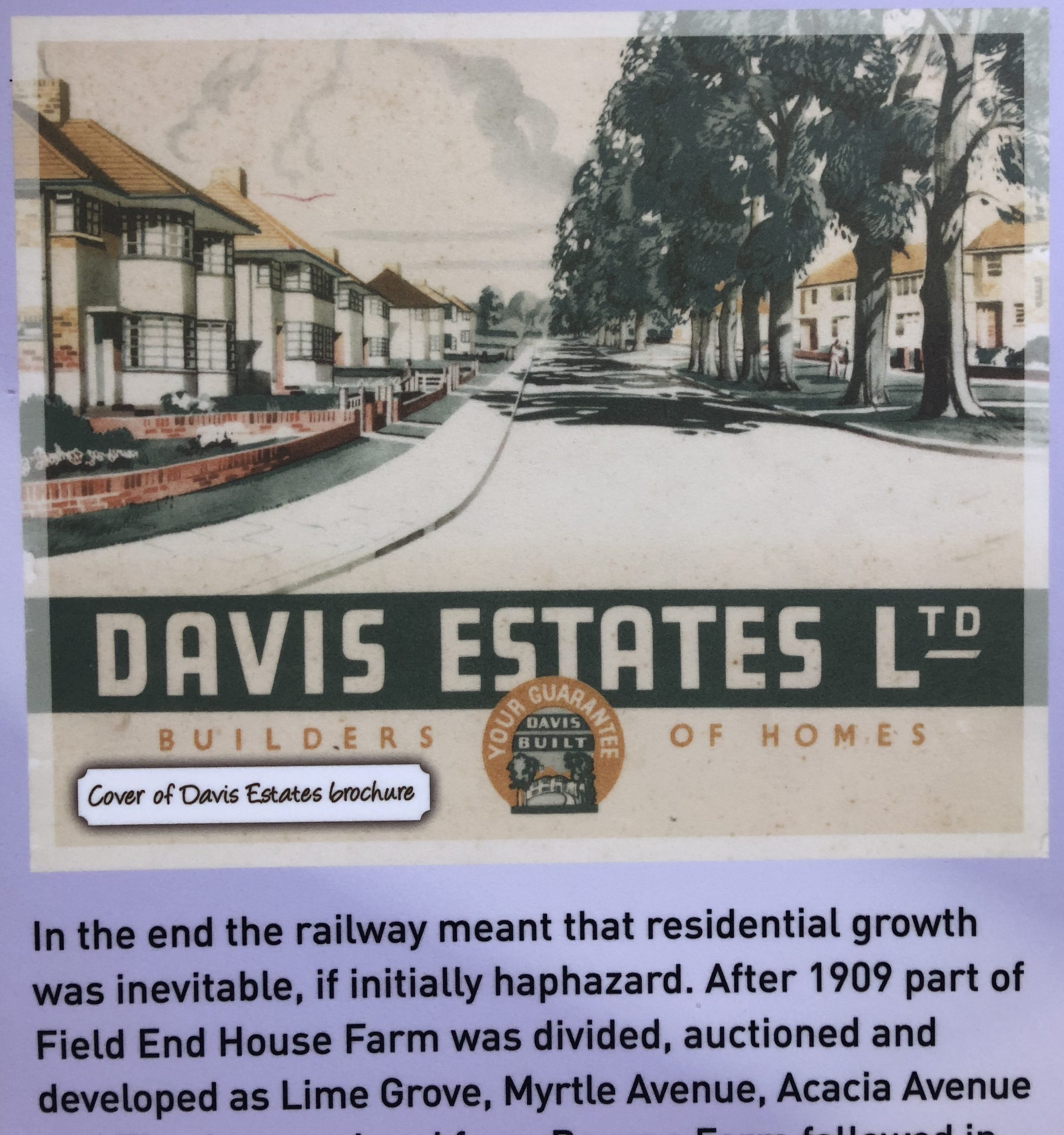
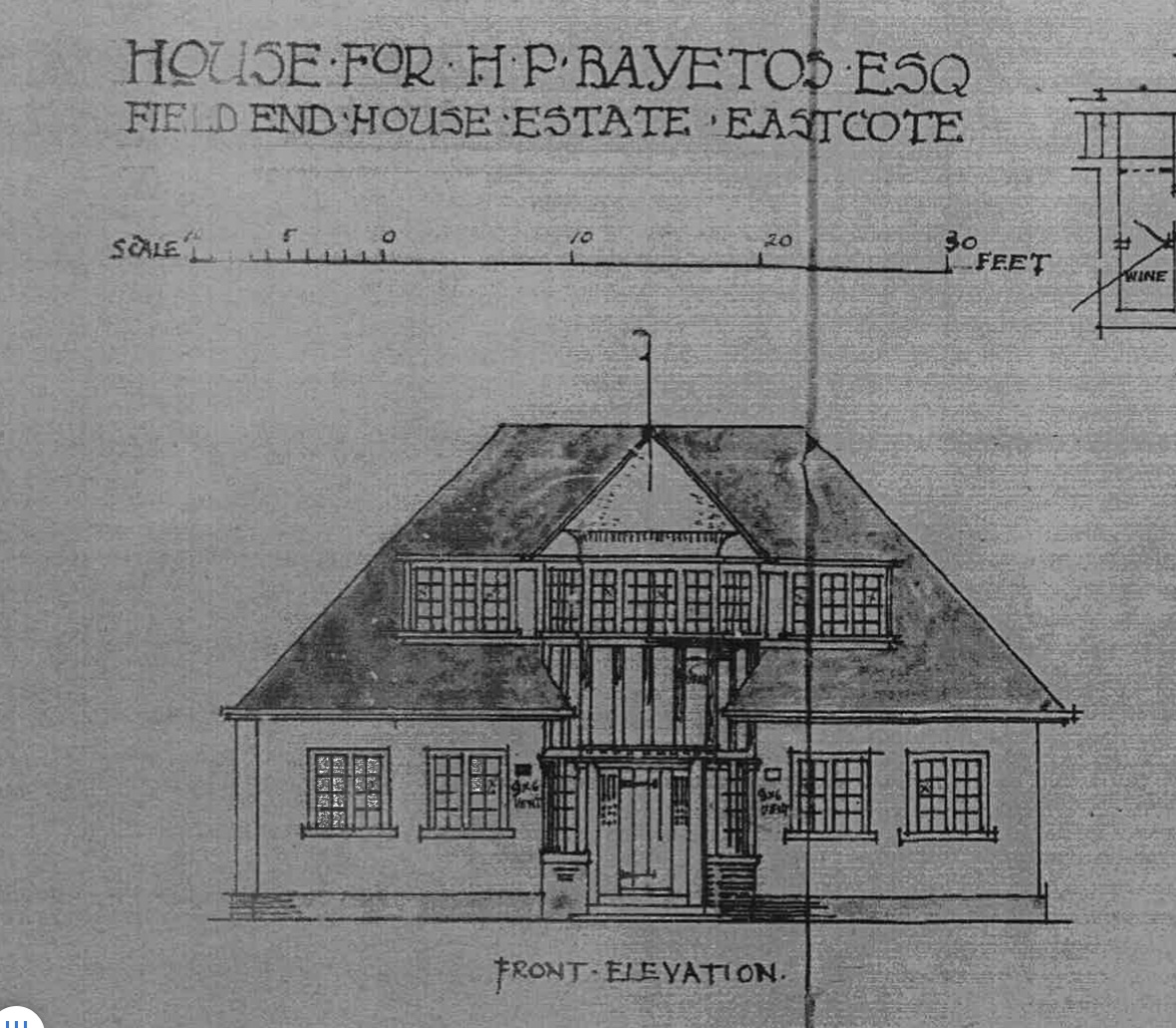
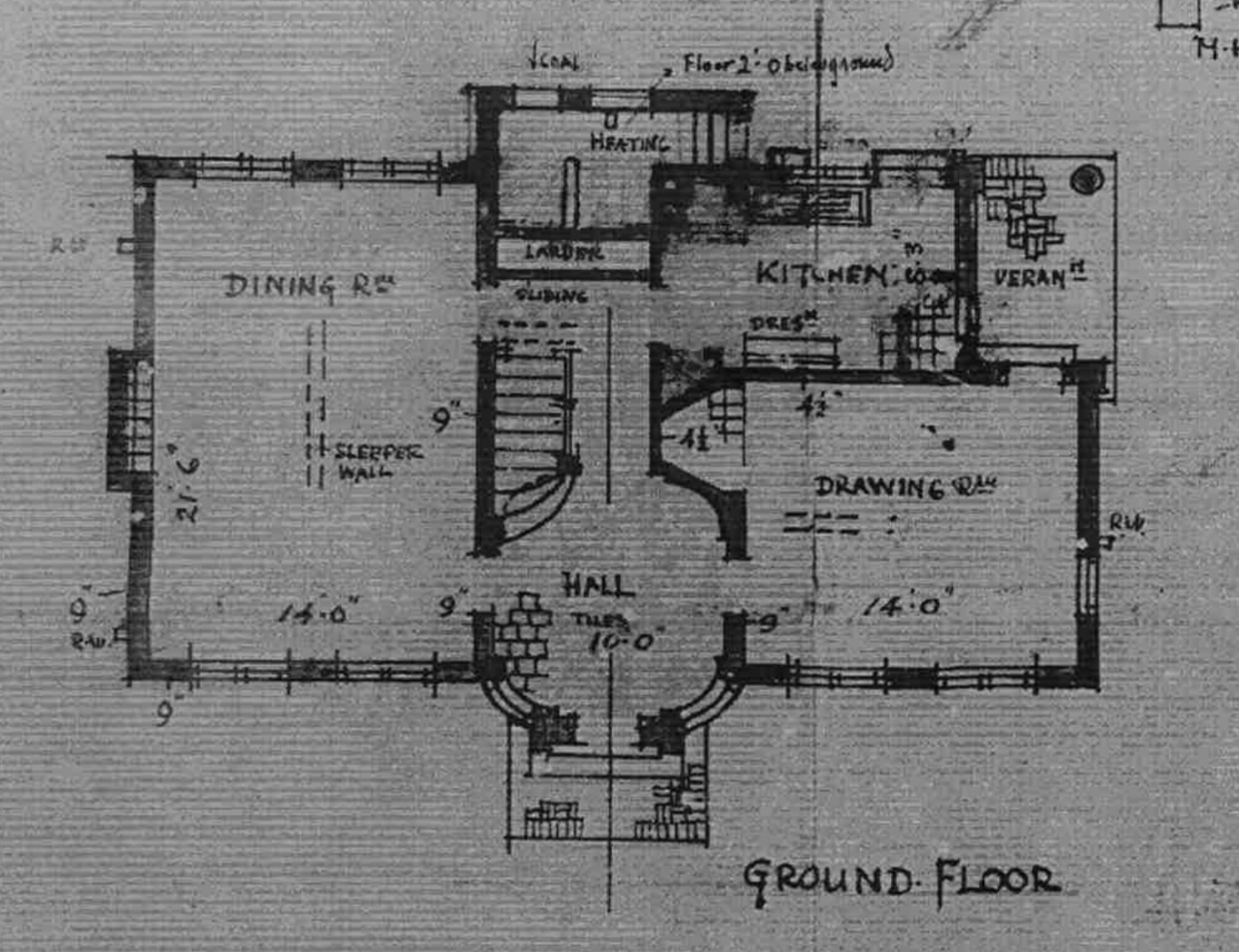

Architect Frank Osler 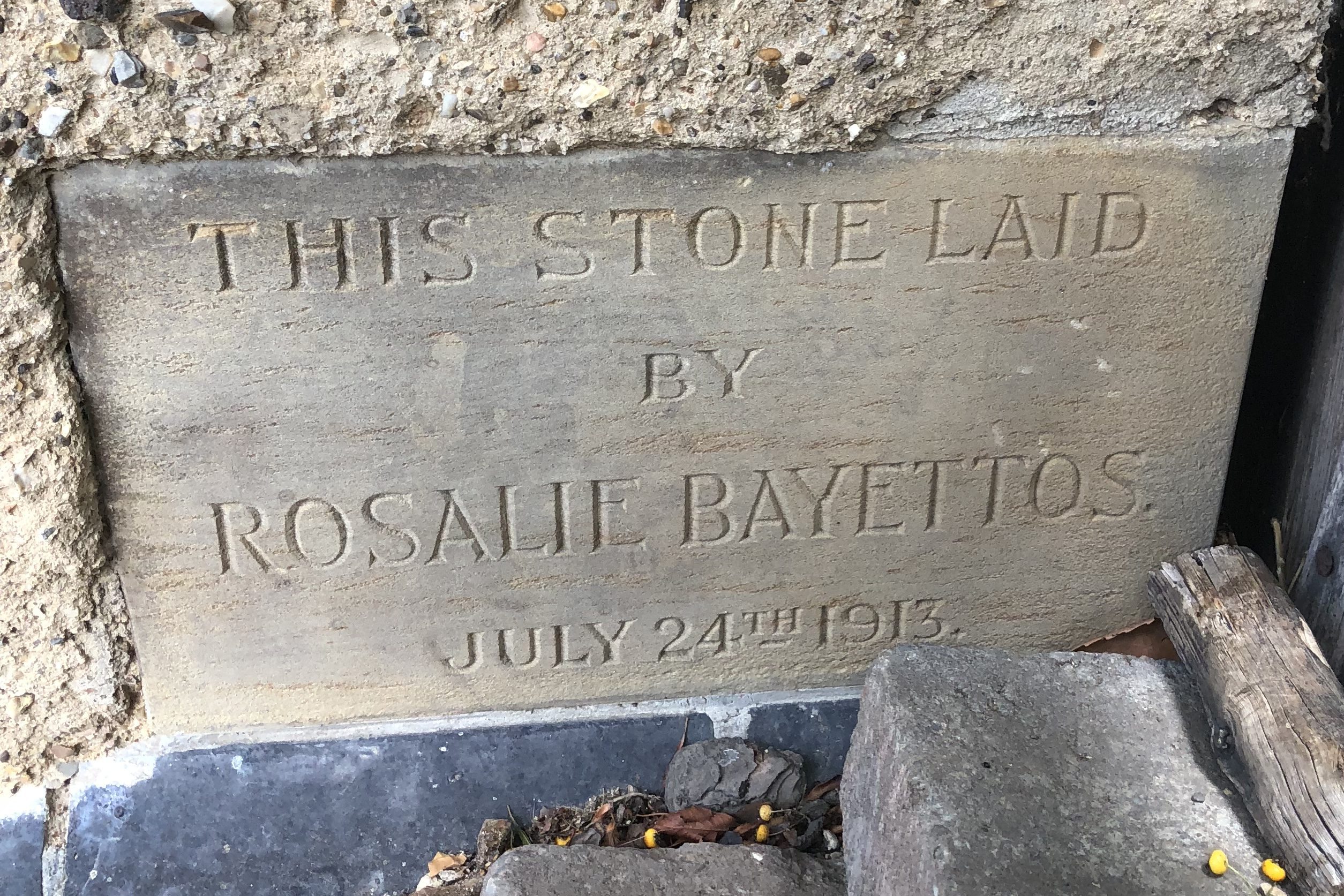
Ye Olde Roses, Lime Grove, Eastcote
The Bayettos Move into their newly built house
The Bayettos move into their newly build house, named Ye Old Roses in Lime Grove, Eastcote on 25 October 1913. [HO 144/1356/261608]
Outbreak of the WW1
The assassination of Archduke Franz Ferdinand in Sarajevo results in the outbreak of the first world war.
The UK enters the War
The United Kingdom declares war on Germany and so enters the great war.
Hippolyte’s naturalisation
Hippolyte’s naturalisation application states that he was living in Eastcote with his wife and two sons and that he was working as head waiter at the Carlton Hotel, Shaftesbury Avenue, London and had been working there for 12 years (ie since 1902). He refers to Tone: “His youngest son is an aviator and earnestly wishes to serve his king and country in that capacity in connection with the war. Your memorialist is informed that his sons acceptance as an aviator for the purpose named might be considered when your memorialist (his father) becomes a naturalised British subject”. [HO 144/1356/261608]

Missing years
No information is available for Tone for about 19 months – from the last record of him flying at London Aerodrome in September 1913 to him joining the Royal Flying Corps in April 1915. His Service record card (AIR/76/29) doesn’t refer to any occupational activity during this period. At his pre-enlistment medical his occupation is recorded as aviator and aero-engineer and so possibly he found some work at Hendon Aerodrome or he may simply have been doing casual work, while living at home with his parents in Eastcote, of a type that he didn’t consider had any relevance to a flying career and so wasn’t worth mentioning in his application to the RFC?
Pre-Enlistment Medical Examination
Medical examination prior to enlistment at age 22y and 325 days. Tone’s occupation was recorded as aviator & aeronautical engineer. “Height 5 feet 8 1/2 inches; weight 144 lb; chest (expanded) 38 inches (4 inches expansion); physical development ‘good’; vision 6/6; scars on left thigh and forearm & 3 scars on abdomen; 5 vaccination marks left arm”. (WO 339/56618)

Tone Joins the Royal Flying Corps
Tone Hippolyte Paul Bayetto of “Ye Olde Roses” Lime Grove Avenue, Eastcote Pinner Middlesex joined the General List on a short service commission (for the duration of the war) with the Royal Flying Corps. He was enlisted at South Farnborough on 26 April 1915 with Reg no 4808 (WO/339/56618).
The Royal Flying Corps was formed on the 13th April 1912 and comprised a Military Wing, Naval Wing, Central Flying School and the Royal Aircraft Factory. The Naval Wing split from the RFC on 1st July 1914 to become the Royal Naval Air Service (‘RNAS’), under the control of the Admiralty. On the 1st April 1918 the RFC merged with the RNAS to form the Royal Air Force (‘RAF’).
The RFC was a Corps of the Army, and thus had Army ranks, regulations and procedures. All of the initial personnel of the RFC Military Wing comprised officers and men who transferred from the Army, and the Army continued to be a significant source of personnel for the RFC, either by permanent transfers, secondment or temporary attachment (the latter categories applying particular to observers).
Officers could initially enter the RFC in two ways: by transfer from an Army Unit or by joining the Special Reserve. The latter were sometimes known as ‘civilian pilots’ as they generally had no military experience. Subsequently it was possible to join the RFC directly and be entered on the ‘General List’ and this was how Tone joined the RMC. Once the officers service in the RFC was over he resigned his commission. There was thus an advantage in joining the Army first and applying for a transfer to the RFC, in that once the RFC service was completed the officer would return to his Army unit for continued employment.
A new officer would normally be appointed as a temporary 2nd Lieutenant or Probationary 2nd Lieutenant and enter the Recruits Depot. He would be given ground training at one of the Schools of Instruction (primarily Reading and Oxford). If destined to be a pilot he would undertake further training and/or assessment at one of the private Flying Schools taken over by the RFC, the Central Flying School or one of the Reserve Aeroplane Squadrons (‘RAS’), later renamed Reserve Squadrons (‘RS’), then Training Squadrons (‘TS’), and subsequently merged into Training Depot Stations (‘TDS’). Alternatively he could be trained as an Observer or Balloon Officer. Officers undertaking ground duties would generally be appointed as Equipment Officers.

Tone Joins No. 1 Flying Squadron
Tone was briefly posted to No.1 Flying Squadron with the British Expeditionary Force in Bailleul, France under the command of Major Philip Bennet Joubert de la Ferte. [REF: 66FS bio]
Tone Transferred to No. 3 Flying Squadron
On 22/11/2915 Tone was transferred to No.3 Flying Squadron based at Auchel Aerodrome, France, commanded by Major D S Lewis DSO (No.3FS was formed in May 1912, moved to France 12/8/1914 and stayed there throughout the war. It moved to Auchel on 1/6/1915) [REF: 66FS bio – ambiguity re dates; see McCudden’s book]

McCudden 14 Dec 1915
James McCudden’s account:
“On the 14th I went out with Sergeant Bayetto, a new pilot of No. 3 Squadron, to show him the lines and the principal landmarks. We were out for over half an hour, as there was not much doing on the line that morning.”
P78 Flying Fury, James McCudden VC
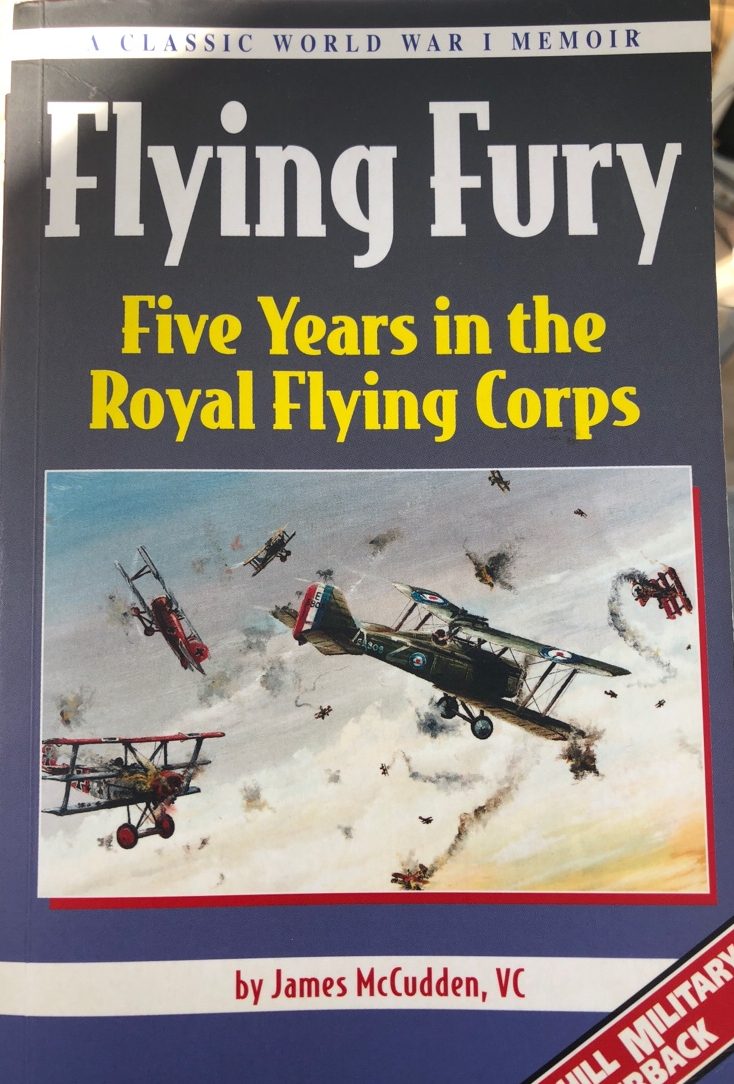
.
McCudden 25 Dec 1915
It is highly likely that Toné spent Xmas evening with James McCudden whose account follows:
“On that evening all the Sergeants in the squadron waited on the men at Xmas dinner, according to an old army custom and the men really did themselves very well. After the men had fed, we retired to our mess, and had our dinner, which was a great success, largely due to our kindly host and hostess, with whom we had our meals in our billet behind the squadron office at Auchel. After dinner we had the inevitable speech-making, at which “Fonso” was at his very best. He also recited a revised version of “Gunga Din” (his own), which family made us scream with laughter. Fonso also had a most extensive repertoire of drawing room stories and he was constantly on his feet most of the evening. Altogether the Xmas of 1915 at Auchel was, I think, one of the very best I have ever spent”
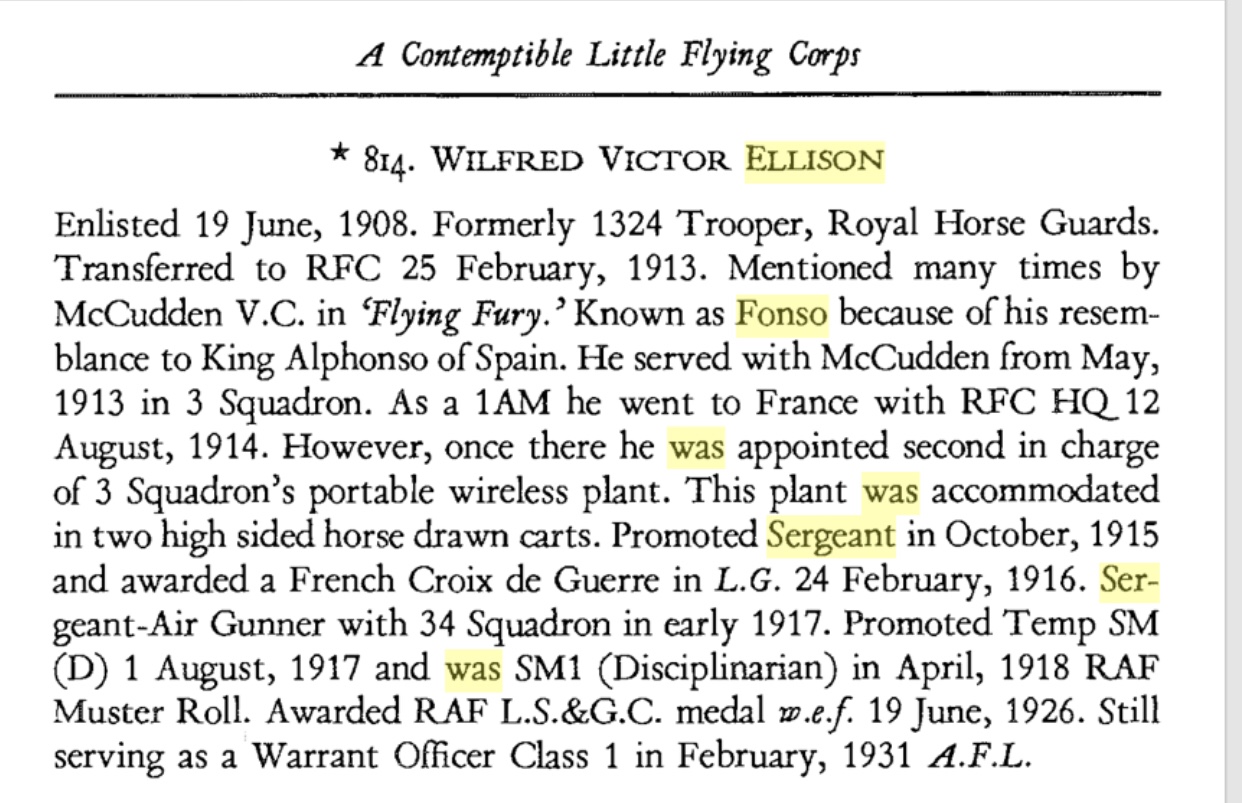
McCudden 30 Dec 1915
James McCudden’s account:
“By now, having flown a good deal with major Hewitt, I intensely disliked ever going up with anyone else, for I can assure you that I knew when I was flying with a safe pilot…… on December 30, 1915, I went up with a sergeant Bayetto to escort some B.E.2c’s of No.2 Squadron who were going to bomb Douai aerodrome. However the weather became very cloudy, and we returned west above the clouds. We were above the clouds for about 10 minutes, and so I told the pilot to go down, and as we saw the ground under the clouds we found we were over a slag heap half a mile from our aerodrome. I need not add that this was much more by luck than judgement.”
P83 Flying Fury, James McCudden VC
.
McCudden 5 Jan 1916
James McCudden’s air combat account while observing with Tone as pilot in Morane Parasol 5081 on escort duty in Douai [WO 339/56618]





“On January 5th I went off again with a Bayetto to escort No.2 Squadron to Douai Aerodrome and back. We met the 2c’s over their aerodrome at 6000 feet and having climbed to 7000, cross the lines just south of Lens. “Archie” gave us quite a good reception, for we were quite a large formation for those days – 15 B.E.’s escorted by two Morane Parasols. Soon after crossing the lines I noticed a German machine very low over the Scarpe, north of Vitry, but as it was so low I took no notice of it. We all arrived over Douai without incident, and the bombers gracefully jettisoned their souvenirs, which did the surface of the aerodrome an awful lot of good, and the local “Archie’s” were just mad with rage. We now all turned West, and our 80 HP Le Rhône started to give an occasional knock. The low machine that I had seen near Vitry on our way was now at our level, and proved to be a Fokker, and it had by this time been joined by two others. This was the first time that I had seen more than one Fokker in the air at one time. The first Fokker had now got behind a 2c on our left, about 300 yards away, and the English pilot had not seen him. I directed my pilot (Toné) to turn so that I could fire at the Fokker at long-range and distract the Fokker pilots attention, which I succeeded in doing at a range of 300 yards. I shall never forget how that Fokker looked on the 2c’s tail whilst the British pilot was calmly flying straight, not looking behind him at all, and no doubt thinking of Blighty home and beauty. To see a Fokker just steadying itself to shoot another machine in the air is, when seen close up close up, a most impressive site, for there is no doubt that the Fokker in the air was an extremely unpleasant looking beast.”
P84 Flying Fury, James McCudden VC
.
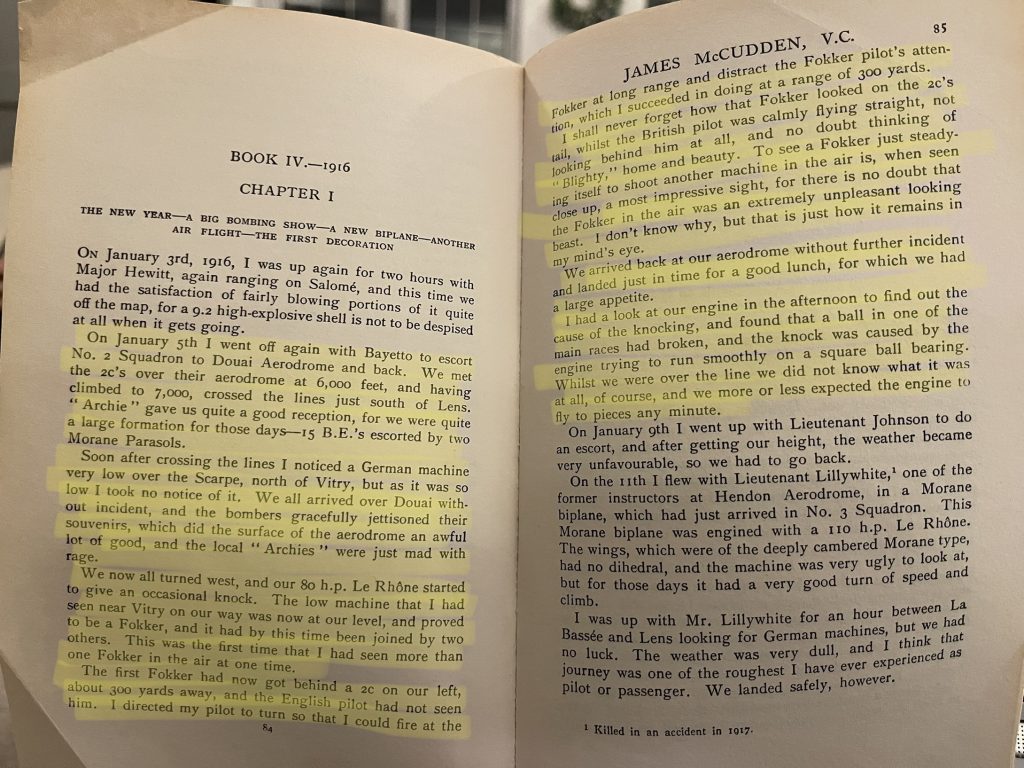
McCudden 12 Jan 1916
James McCudden’s account:
“Between 12 – 18th I made several flights, but nothing happened of note except that one morning I went up with a certain pilot in a 40mph wind, and as soon as we were off the ground he turned and flew downwind about ten feet high, past trees, ditches and houses, made one circuit and landed again. I don’t know what he did it for, but I do know that I was absolutely terrified, for by now I had done a lot of passenger flying, and I knew whether a plane was being flown properly or not, and this one was certainly not. However we got down safely, and that was the main thing.”
P86 Flying Fury, James McCudden VC
.
Air Combat & Tone’s first ‘kill’ & loss of two colleagues on 2 Mar 1916
Toné & Immelmann – Morane Scout 5067
On 2 March 1916, Charles Walter Palmer and Lt Herbert Frederick Birdwood were engaged on a long reconnaissance deep over the lines, in a Morane BB (5137). The route to be patrolled was Auchel-Douai-Valenciennes- Douai-Lille-Auchel. They were escorted by Sgt Tone H Bayetto, who was flying a Morane N (5067). Tone reports that when leaving Douai the patrol was attacked by one Fokker, which followed and as they arrived at Valenciennes another four Fokkers engaged them. Bayetto then shot a drum of tracer at the nearest aircraft which he reports as 'nose diving into woods near Valenciennes with the appearance of being on fire'. They were then archied and the fight broke up after five-ten minutes. Bayetto had then lost sight of the Morane BB and returned home via Lille where he reports being attacked by another three Fokker single seaters. Palmer and Birdwood were engaged and shot down on their return by Immelmann, who was based at the airfield of FFA-62 near Douai. Birdwood's gun had jammed (information in Palmer's last letter home) and they were unable to protect themselves from the attack. Birdwood died immediately from bullet wounds and Palmer was captured but later died on 29 March from blood poisoning following amputation of his foot on 17 March.
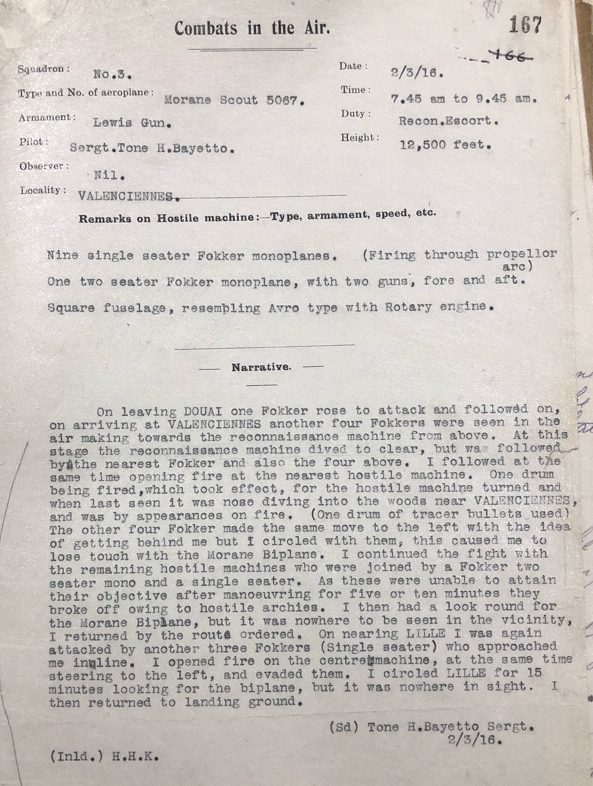
Royal Flying Corps Communiques 1915-16: "2 March Sgt Bayetto (Morane Scout, 3 Sqn) on escort duty to the Valenciennes reconnaissance reports having been attacked by five Fokkers in the neighbourhood of Valenciennes. The reconnaissance machine dived to get clear, but was closely followed by the hostile machines. Sgt Bayetto opened fire on the nearest hostile machine and drove it down, apparently into woods near Valenciennes. After this engagement he saw no more signs of the reconnaissance machine and returned over Lille where he was again attacked by three Fokkers. These he eventually evaded and after circling around Lille for 15 minutes, returned to his landing ground." [Christopher Cole, Royal Flying Corps Communiques 1915-16, (Donovan, 1990) ISBN 1-871085-03-9, p122]
The Hinckley and Bosworth Herald: “After a thrilling fight in mid air, Flight Lt Palmer, the brilliant Hinckley aviator has fallen into the hands of the Germans. He was piloting a machine on distant reconnaissance at the time, and engaged with Immelmann and other German aviators for fifteen minutes, his observer being killed and himself wounded.” [The Hinckley and Bosworth Herald, Saturday 25 March 1916].
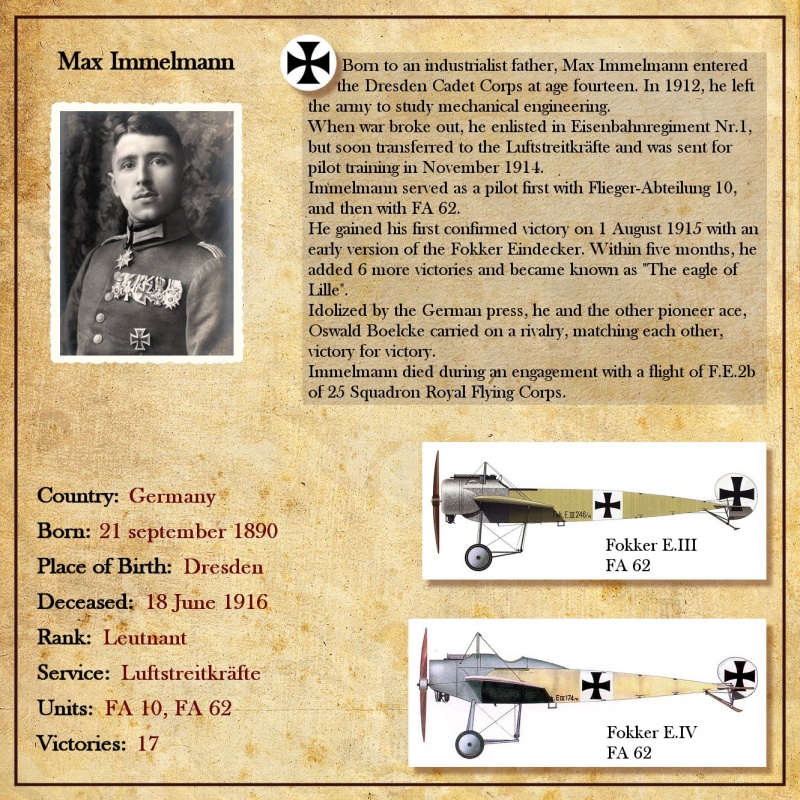
Immelmann: “At last some more arrived on March 2nd, I went up that day to take over the air barrage between Lens and Arras. I was about 2200 metres up when I suddenly saw an English biplane heading for me. It was about 2400 metres up, and close behind it, about 100 metres away, there was a monoplane. A Fokker I thought, and rejoiced at the idea that it was going to shoot the Englishman down. But it did not shoot. I took my glasses and saw (by the markings) that it was another Englishman. The next moment the two of them came down on me, firing as they dived. Being 200 metres below them I was defenceless. I escaped their onslaught by a nose-dive of 100 metres and flew a bit to westward while the Englishmen were flying east. Then I went into a swift turn, which brought me behind my opponents. They were 2200 metres up and I 2100. Then the pursuit began. The two of them were flying straight for Douai the distance between us increased continually. My engine was running badly. I thought it was most necessary to climb, but the Englishmen climbed as well. The two of them were up to about 3000 metres over Douai, and I was 2800. It was absolutely imperative for me to get higher if I meant to attack them, or to at least reach their height. I considered whether it would not be better for me to land, for I could do simply nothing with my engine. The two flew on towards Valenciennes, finally they looked only as big as flies. I got all the climb I could out of my engine; as there was no hope of overhauling them, I meant to cut them off on the way back. I succeeded in that and met the couple half way back from Valenciennes and Douai. I was now at 3200 metres up and they were 3100. Then the fun began. The English biplane led followed by the monoplane which had a device for shooting through the propeller that seemed similar to my own. I put my machine behind the monoplane and began to shoot. He on his part tried to get on to my neck. He planned to put himself behind me by means of a wide turn, and I used the moment to attack the biplane, keeping one eye on the monoplane, I shot at its companion everything I could get out of my gun. In this way I forced the biplane down to 2500 metres, whence it descended in a steep glide and landed. It was not advisable for me to turn on my other enemy, the monoplane after that, for firstly I could not make up the lost 500 metres of height with my bad engine and secondly I had a gun jam. So I let the monoplane buzz off in the direction of Lille and went home. News had already come through by telephone that an Englishman had landed at Souain [This not thought to be right and should be Somain ]. After receiving congratulations on all sides, I asked for a car. As chance would have it, Lt Claus, an old friend from the cadet corps, had come along to pay me a visit while I was still in the air. We drove off to the landing place together. The pilot (Lt Palmer) had been bandaged and was sitting in a car. He had a wound to his foot. On a stretcher close at hand was the body of the dead observer (Lt Birdwood). There were many bullet wounds in it. The machine had landed undamaged; it was dismantled and sent to our section. The machine carried two guns. The pilot used one of them to fire in front, just as I do, while the other was manned by the observer in the rear. The second machine gun was missing, it had fallen out of the dead observer’s hands and was found several kilometres away from the landing place. The Englishman said “Well, if I have been shot down, I am at least glad that Immelmann is my conqueror”. We then drove back, to the accompaniment of cheers from the assembled crowd. The machine was quite a new type, making its first flight at the front.” [From Immelmann, The eagle of Lille].
Some questions have been raised about Tone's account by John Grech in Immelmann's ninth victory, Cross & Cockade Int. 1995; 26(4):191-196.........
In Immelmann's account he makes no reference to any other Fokkers or of any one joining the fight.
Bayetto reports "I continued the fight with the remaining hostile machines who were joined by a Fokker two-seater mono and a single seater." This must be a mistake as there were no Fokker two-seater monoplanes, although there were odd occasions when passengers were carried in monoplanes.
Bayetto reports being in the air for two hours, yet J.M. Bruce in his volume 'The Aeroplanes of the Royal Flying Corps, Military Wing', (Putnam, 1992), ISBN 0-85177-854-2, p302, gives the endurance of the Morane N as one and a half hours.


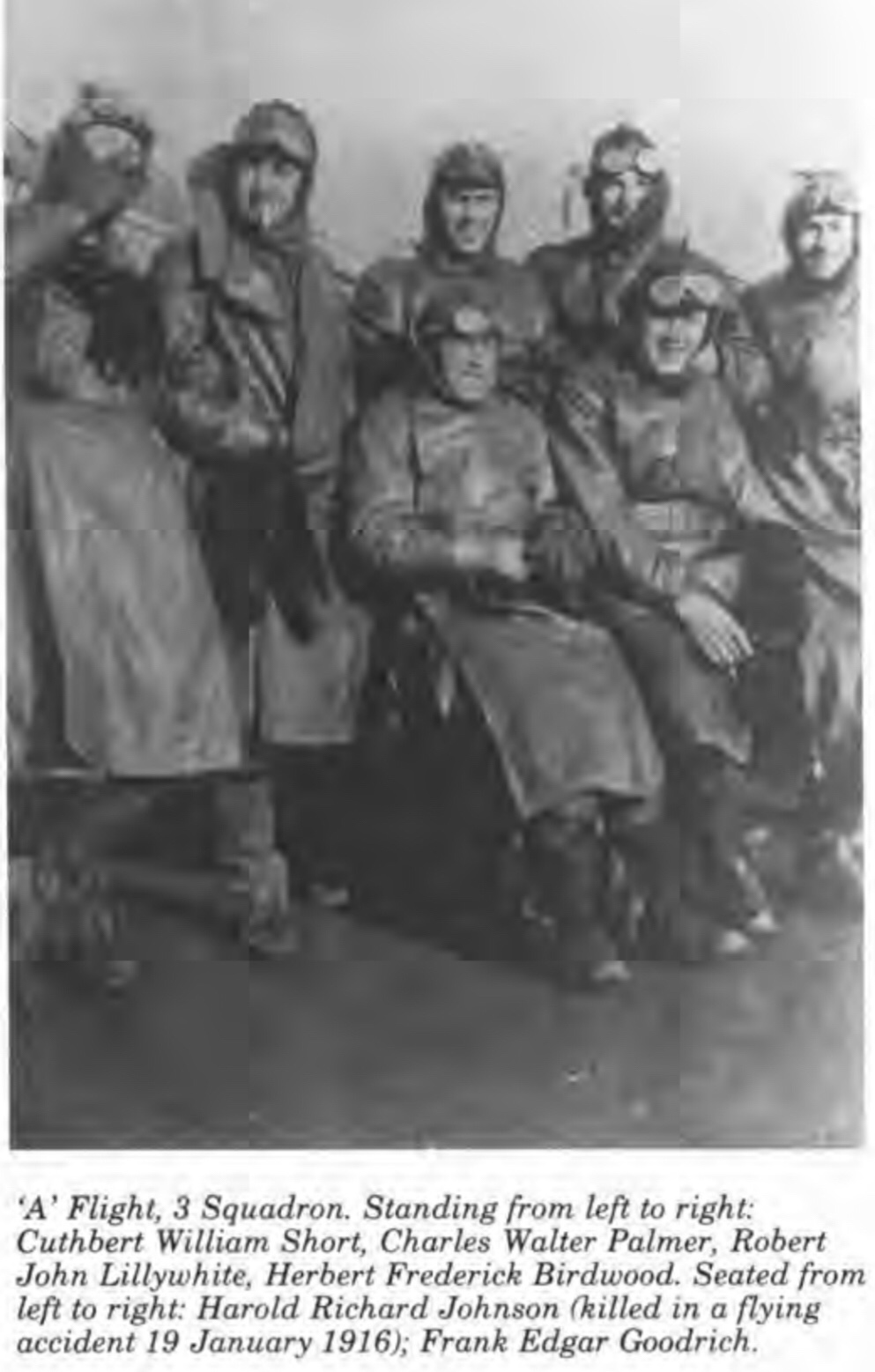
Cross and Cockade International Vol26/4 1995 p191
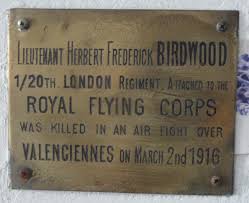
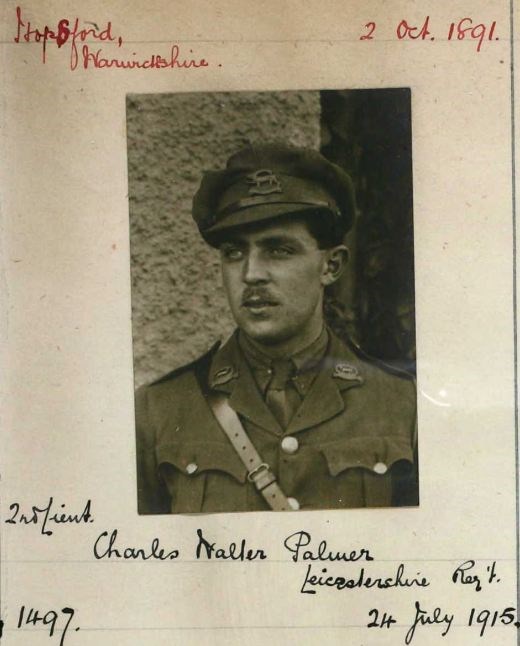
Charles Palmer was shot down by Immelmann On 2 March on his return from a reconnaissance to Valenciennes. His observer, Birdwood’s gun jammed (information in Palmer’s last letter home) and they were unable to protect themselves. After capture, the Germans dropped a message and his flight commander Hubert Harvey-Kelly wrote home to Mr Palmer on 15 March informing the family that Charles was missing, and wounded in the foot, whilst on a reconnaissance far over the German lines, and that they were attacked by Immelmann: ‘Immelmann one of Germany’s most daring pilots was amongst those that attacked your son’s machine’. Palmer died on 29 March 2016 and was buried with military honours on 31 March in the communal cemetery in Douai.
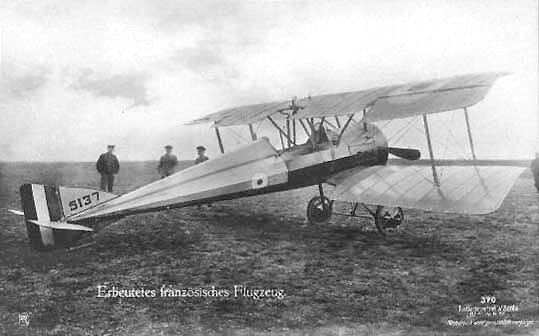
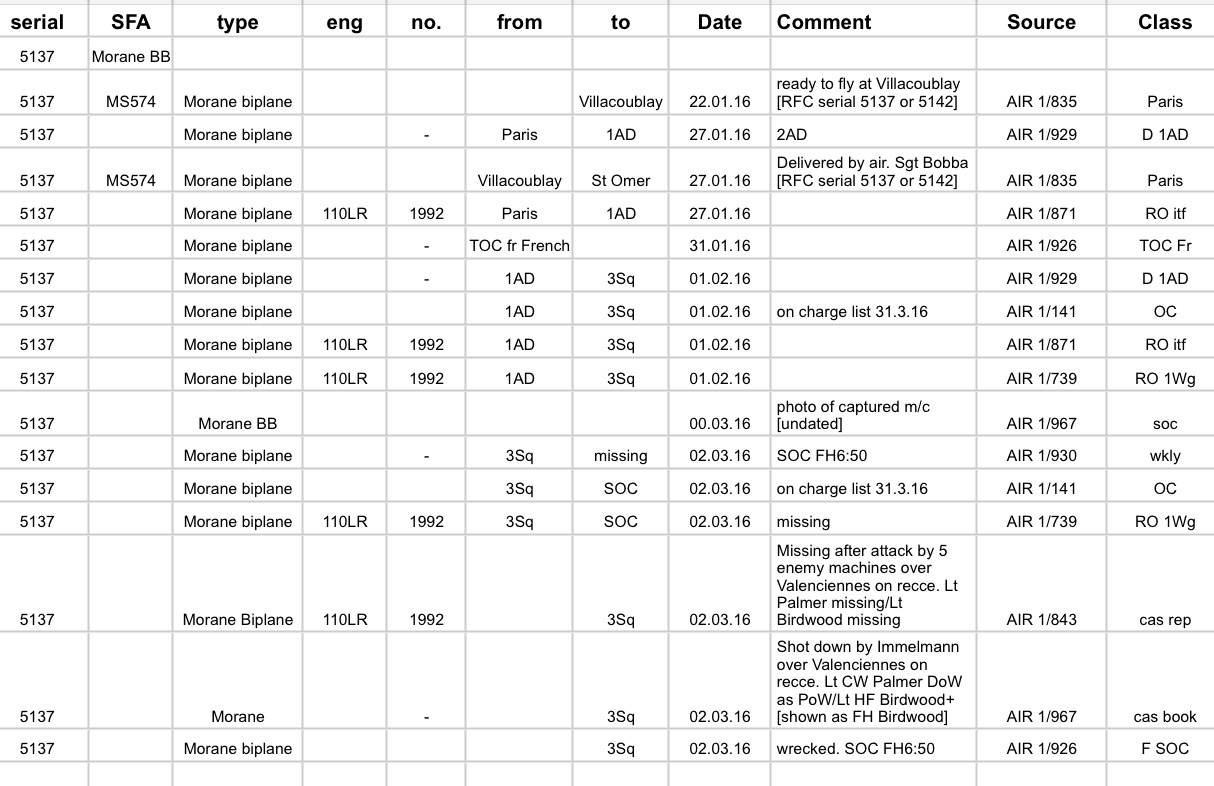
2Lt Charles Walter Palmer and Lt Herbert Frederick Birdwood were flying a new Morane BB serial number 5137. It had been delivered to 3 Sqn (attached to 15 Corps) who were based at Lozinghern/Auchel as part of 1 Wing, on 1 February 1916, from 1 Aircraft Depot to which it was delivered on 27 January 1916. It was equipped with a 110hp Le Rhone motor number 1992. Armament consisted of two 0.303 inch Lewis guns numbers 71 and 3948. They carried nine drums of ammunition, but were not carrying any cameras. The biplane was SOC on 2 March 1916.
Appointed to a Commission with RFC
Tone was appointed to a Commission as temporary Second Lieutenant and posted to the General List for duties with the Royal Flying Corps.





Logistics 26 April 1916
Tone flies Morane (LA) Parasol 5135 from 1 Aircraft Depot, St Omer to 1 Reserve Squadron, Gosport, England, shortly before No.1 RS became No. 60 Flying Squadron.

Logistics 29 April 1916
Tone flies Morane (LA) Parasol 5140 from 1 Aircraft Depot, St Omer to England and in a couple of days it was back in France with the newly formed No.60 FS as part of the Expeditionary Force.
After a few days at St. Omer we received our machines, which were Moranes of three different types: “A” Flight had Morane “bullets,” 80 h.p. ; ” B ” Flight, 110 h.p. Morane biplanes ; and “C” Flight, Morane “parasols.” Of the ” parasol,” a two-seater monoplane, it is unnecessary to say very much, as they were soon replaced by “bullets,” and “C” Flight did practically no work on them. The machine is best, perhaps, described as a biplane without any bottom planes, by which is meant that the wings were above the pilot’s head, a feature which suggested its nickname. It had an 80 h.p. Le Rhone at that time, almost the best air-cooled rotary engine. They were good for artillery registration, as the view downward was excellent ; they were very stable also, easy to fly and to land, and, in fact, were ” kind ” machines, giving their pilots the sort of feeling afforded by a good- tempered, confidential old hunter.
SIXTY SQUADRON R.A.F, A HISTORY OF THE SQUADRON FROM ITS FORMATION BY GROUP-CAPTAIN A. J. L. SCOTT

Logistics 1 May 1916
Tone flies Morane (N) Scout (“Bullet”) 5067 from 1 Aircraft Depot, St Omer to England where it is allotted to the newly formed No.60 FS on 5 May.
The Morane “bullet,” with a 80 h.p. Le Rhone engine, was quite a different proposition. This was a monoplane with a fuselage (body) of the monococque, or cigar-shaped, type and very small wings, giving, therefore, a very high loading per square foot of lifting surface. The speed near the ground was not too bad for 1916, being about ninety to ninety- five miles per hour, but, owing to the high loading on the wings, the machine became inefficient at a height. It had the gliding angle of a brick, as a pilot moodily complained after an unsuccessful forced landing. It is obvious that, if a machine has a very small wing surface, it must be kept going fast, when gliding without the engine, to preserve its flying speed, and this can only be done by keeping the nose well down ; hence the unfriendly description quoted above. Above 10,000 feet it was difficult to turn a ” bullet ” sharply and steeply without ” stalling ” ; moreover, in bad weather it was very uncomfortable to fly, giving the impression that it was trying its best to kill the pilot all the time. The lateral control, 1 of the ” warp ” type, was to some extent responsible for this. The armament was a fixed Lewis gun firing through the propeller, which was fitted with a metal deflector a steel wedge which prevented the propeller being shot through. There was no synchronising gear on any of the Moranes. By this is meant the device by which the detona- tion of the gun was harmonised with the beat of the propeller ; actually the gun is blocked when the blades of the propeller are in the line of fire.
SIXTY SQUADRON R.A.F, A HISTORY OF THE SQUADRON FROM ITS FORMATION BY GROUP-CAPTAIN A. J. L. SCOTT

Logistics 3 May 1916
Tone flies Morane (N) Scout 5191 from N0.2 Aircraft Depot, Candas, France to No.1 Aircraft Depot, St Omer, prior to its transfer to No.60 Flying Squadron on 11 June.

Tone’s Attachment to No.24 Flying Squadron
Tone was detached from No.3 FS to no.24 Flying Squadron (along with Frank Goodrich) in late May 1916. At that time No.24 FS was commanded by Major Lanoe Hawker at Bertangle and were fully equipped with Geoffrey de Havilland’s DH2s – single-seat pusher fighters – the World’s first ever fighter aeroplane unit in the field.
http://ww1aviationheritagetrust.co.uk/?page_id=158)
In the middle of June three Bristol Scouts and *two Morane Monoplanes with their pilots* were withdrawn from the corps squadrons of the third wing and attached to 24 Squadron. The third wing scouts were not replaced when they became casualties and their numbers dwindled away until, by the end of July, they ceased to exist.
CCIJ – 53. Hawker VC. by Tvrrel M. Hawker (Mitre Press. 1965). p176

from: Somme Success, p51
Patrol 28 May Patrol
On May 28 Tone and Frank Goodrich flew patrols in Moranes 5195 and 5180. [CROSS & COCKADE INT. 1995; 26(4): 191-196]

Action on 18 June
On June 18 Toné in Morane 5195 attacked two Albatri over Bois d’Avluy. The Albatri were flying at 6500ft, Tone dived from 13500ft, the Albatri split up when attacked and Tone was forced to cut short the chase because he did not have much fuel. [AIR 1/169/15/160/5 ; CROSS & COCKADE INT.1995;26(4):191-196]

Patrol 21 June 1916
Tone flying Morane Scout 5195 returned owing to clouds coming over thick. [AIR 1/169/15/160/5]

Patrols on 23 June 1916
Tone in MS 5195 two missions. No HA seen. On the second mission he landed at La Houssaye to refuel after two hours flying. [AIR 1/169/15/160/5]
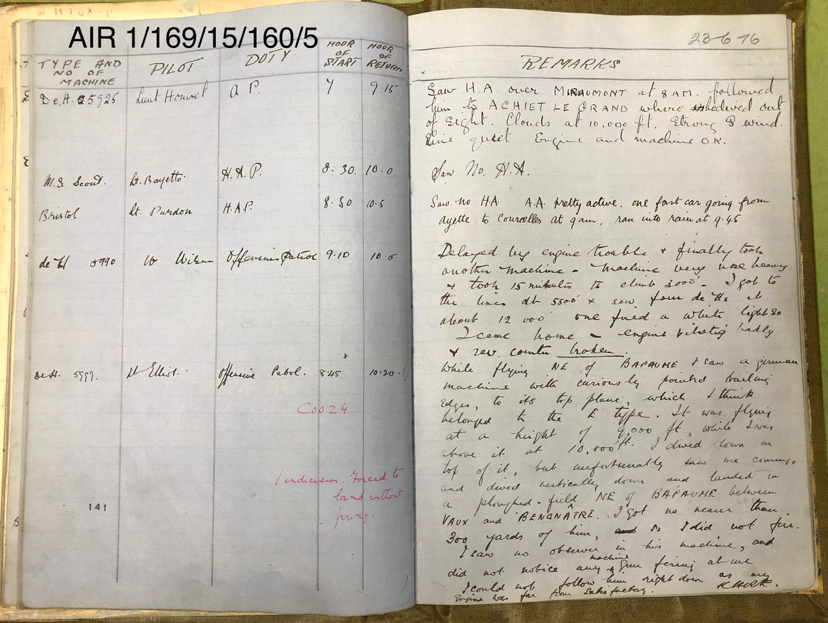
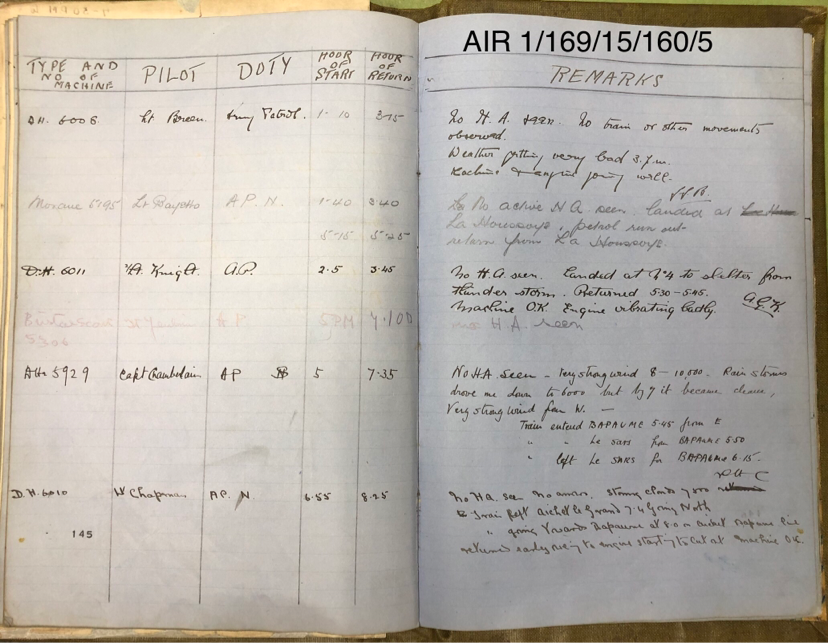
Patrol on 24 June 1916
Tone in Morane Scout 5195 Reports: “Cross line at 3000ft and patrol the other side of line between Miracort and Combles” [AIR 1/169/15/160/5]
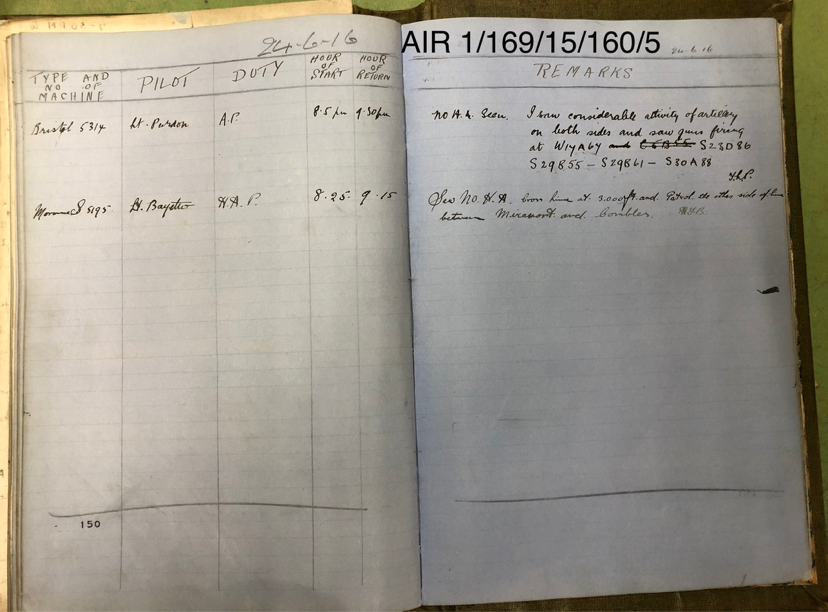
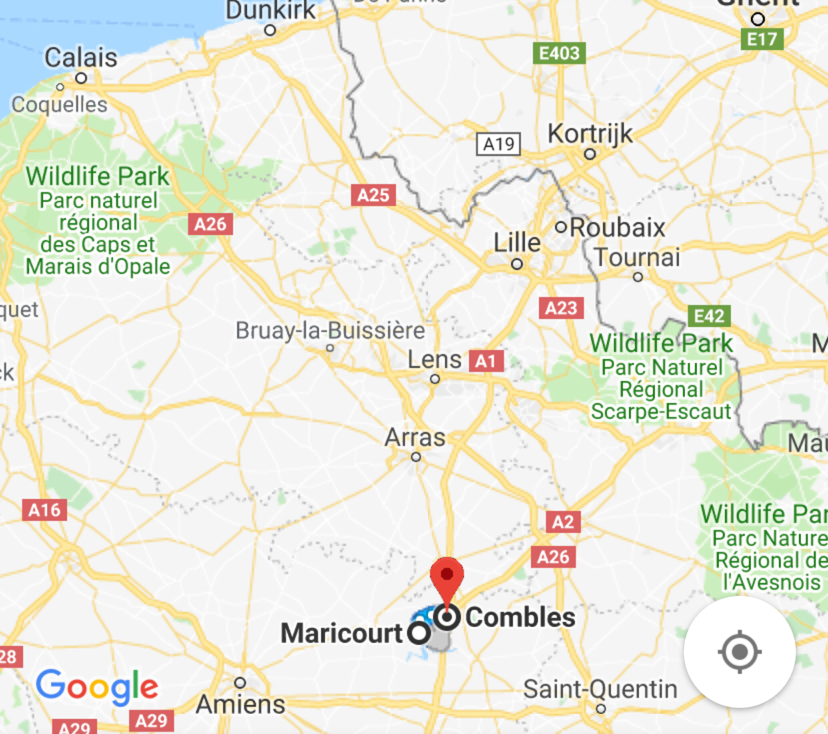
Action on 25 June 2016
On June 25 Tone attacked two Fokkers near Boursies both of which landed on an enemy aerodrome. Tone was then shot at by German anti-aircraft fire and he made his escape. Later the same day he saw two LVGs near Bois de Logeast whilst on patrol. [CROSS & COCKADE INT.1995;26(4):191-196]
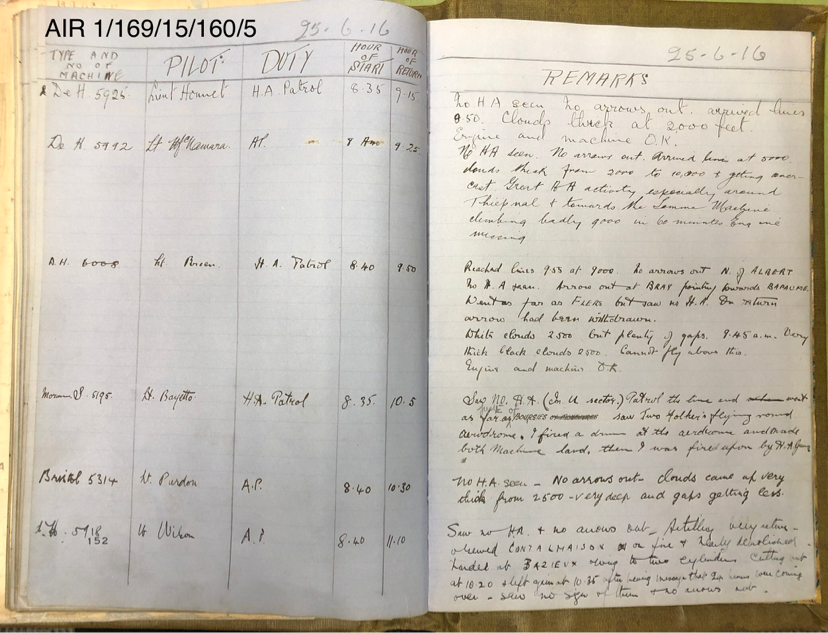

‘kill 2’ 1 July 1916
On 1 July (first day of the Battle of the Somme) an offensive patrol was mounted by 24 Sqn from 1230am until 1430pm. Taking part were Lt Purdon in Bristol C Scout 5134, Lt Bayetto in Morane N Scout 5195, Lt Wilson in DH2 5198, Lt Morgan in 6011, Lt Sibley in 5990, Lt Wood in 5967 and Lt Knight in 5931. They met some FE2b’s over Bapaume and escorted them back to the lines. Three enemy aircraft were seen over Biefvillers and were attacked by Tone and Knight, Tone forced the aircraft he attacked down and Knight gave up the chase over Bapaume. [CROSS & COCKADE INT.1995;26(4):191-196].
“. . . . The third patrol of this squadron when over Bapaume saw, far below, three German aeroplanes flying at about a thousand feet. Second lieutenant T P H Bayetto, on a Morane Scout, dived and forced one of them to land in a field: the other two flew away.”
H A Jones The War in the Air Vol 2


Crash Landing 2 July 1916
On 2 July (2nd day of Battle of the Somme) Tone in Morane N Scout 5195 twice attacked a balloon near Flers, forcing it to be hauled down. During the second attack he was hit by ‘archie’, damaging his propeller and one valve rocker, bending and twisting others. The engine cowl was torn off and one warping wire was shot away, he was thrown into a side-slip, but regained control and climbed to 2500ft. Tone’s motor was only developing 7-800 revs and vibrating badly, he landed on the British side of the lines near Carnox, and arranged for the machine to be moved across fields one and a half miles for collection by squadron transport. [CROSS & COCKADE INT.1995;26(4):191-196].




Engine Problems 6 July 1916
Toné in Morane Scout 178A SSE no EA but was forced to land due to minor engine problem [AIR 1/169/15/160/5]

Engine Problems 8 July 1916
Toné on escort patrol in Morane Scout 178A but returned owing to engine trouble [AIR 1/169/15/160/5]

S
Patrols 9 July 2016
Toné on two patrols in Morane Scout 178A. First: “saw arrow out at Albert, but could not find HA machines. Engine missing all the time I was up.” Second: “Saw no HA over Trones Wood. Saw two HA north of Bafaume at about 1000ft going NE. No other HA seen” [AIR 1/169/15/160/5]

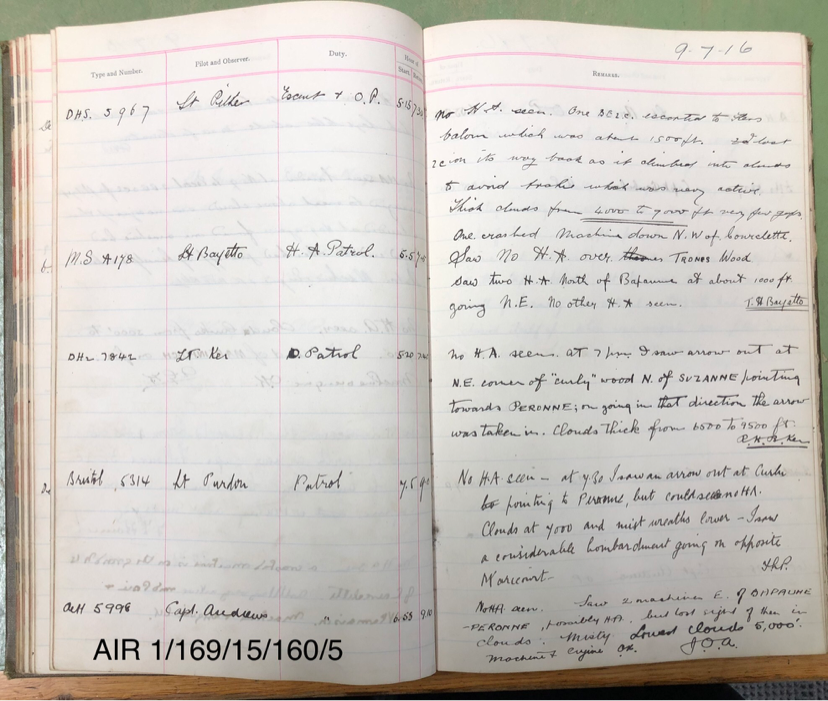
Test & Escort Flights 15 July 1916
Toné had a morning test flight in Morane Scout 178A “testing new engine and wings”. Four evening fights as escort to no.3 Squadron “down at HA over Beaulencourt but found it to be a Nieuport Scout. Climbed up again and continued escort. Landed at No. 3 Sqd again owing to oil not pulsating in glass” [AIR 1/169/15/160/5]

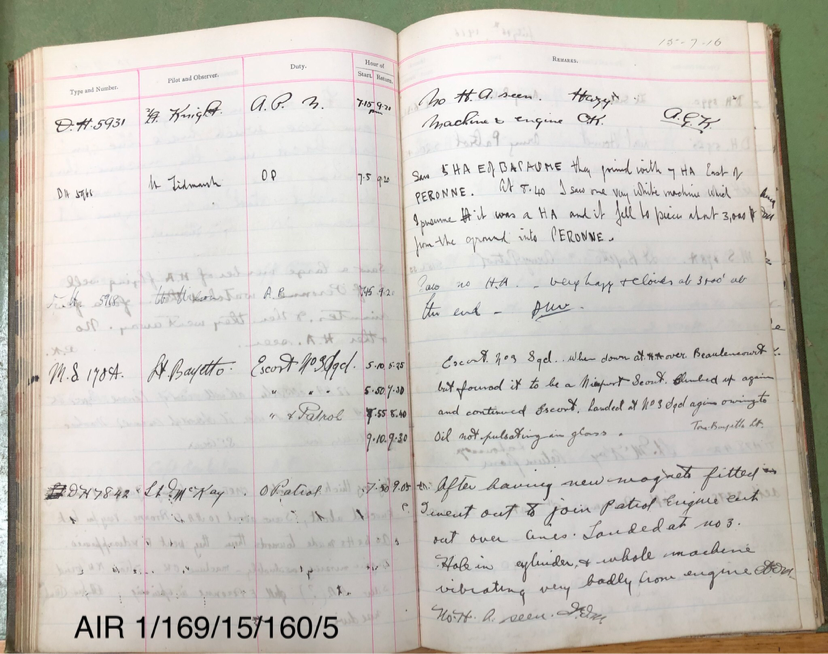

Army Patrol 16 July 1916
Toné on army patrol in Morane Scout 178A. “Lost DH in clouds. Saw FE at 6,000ft so I climbed up to it but found I could not see the ground. Came down under the clouds over Peronne. Clouds then were at 3,500ft. Later in a thick layer of clouds came up at 500ft. Very active movements by our troops and heavy shelling on the front between Martinpuich and Flers”.
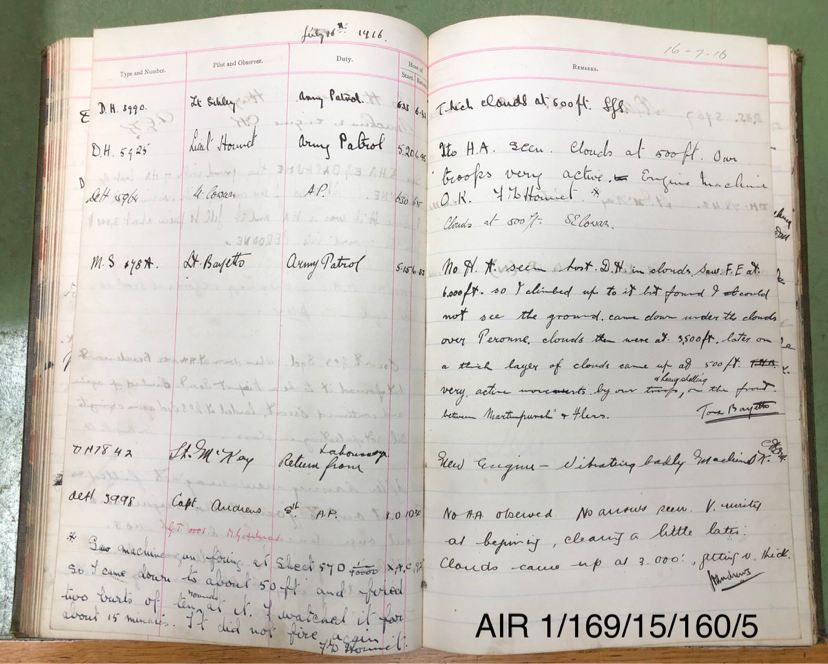
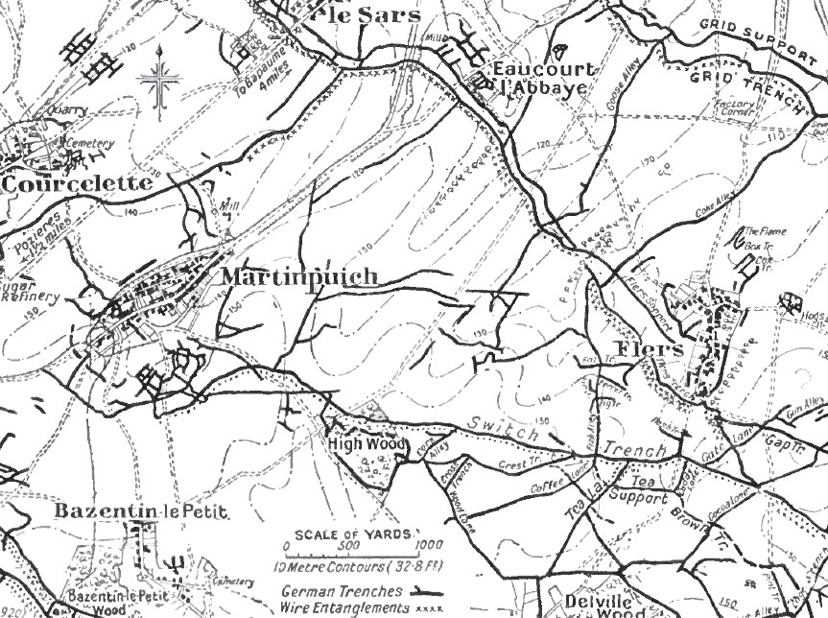
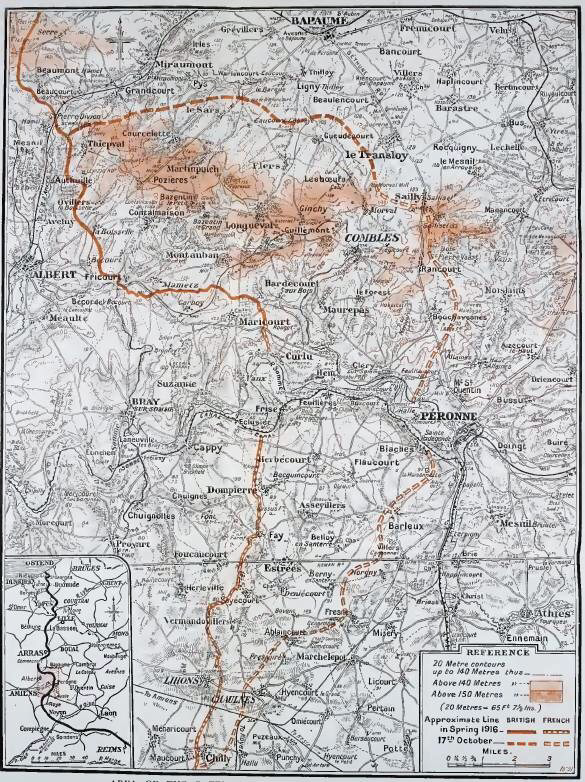
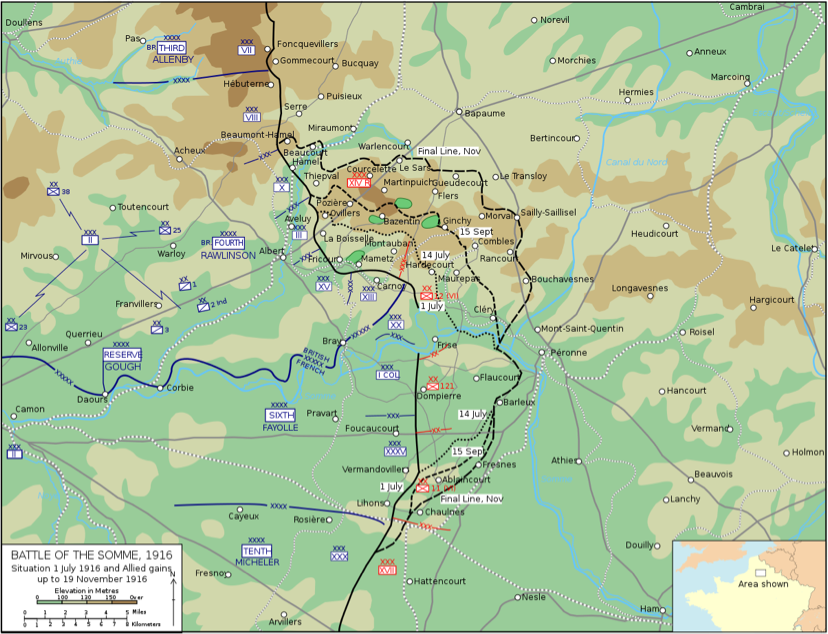
Narrow escape, 19 July 1916
Tone was flying Morane A178 in the morning when he was attacked by three German biplanes, thought to have been Rolands, and managed to escape by diving away. Whilst in the dive the Morane inverted and the tail dropped and started to spiral. Tone was then forced to flatten out before making his way back. That afternoon/evening he made four further flights as escort to no.3 Squadron during which he had to land at no 3 Sqdn “owing to engine trouble”. [CROSS & COCKADE INT.1995;26(4):191-196; AIR 1/169/15/160/5]. Aeroplane photo: Cross & Cockade Intl Winter 2014 45.283]
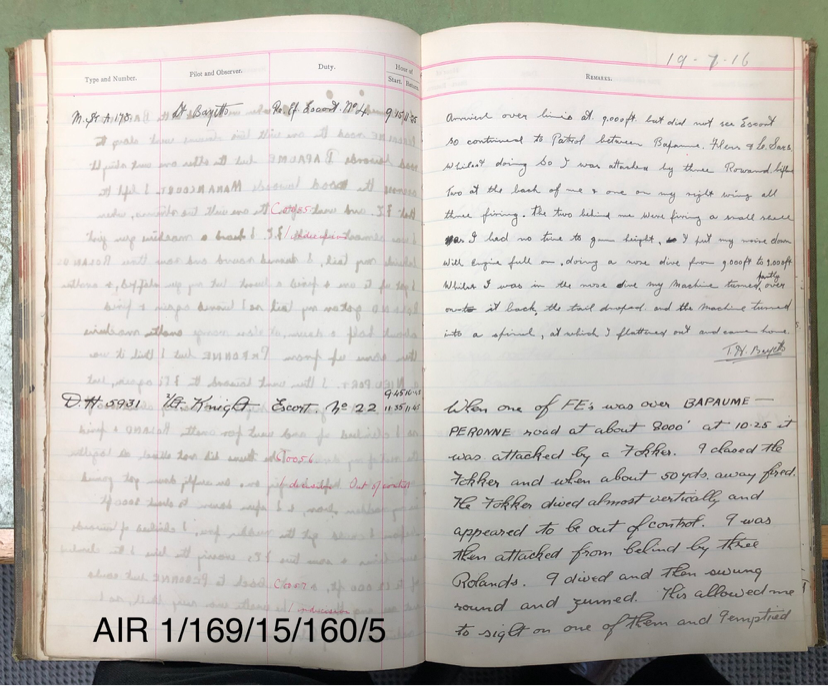
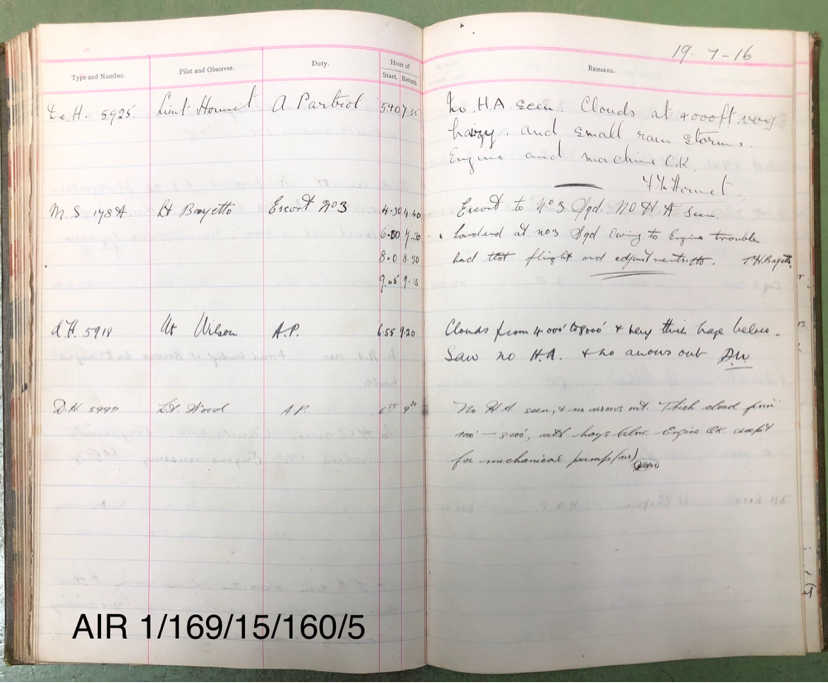

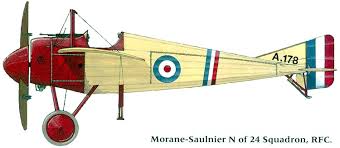

‘Kill 3’, 20 July 1916
On 20 July Toné was conducting escort and patrol duties in MS178A He engaged a hostile which was being chased by a Nieuport. He saw his Buckingham tracers enter the fuselage and right wing as the”Hun machine dived and turned to the right and entered a cloud. The Nieuport and I dived beneath the clouds but could not see the HA owing to thick atmosphere”. [CROSS & COCKADE INT.1995;26(4):191-196, AIR 1/169/15/160/5]

Engaged Hostiles and Gun Jam 21 July 1916
On 21 July Toné engaged hostiles twice during an early afternoon army patrol in MS178A but on both occasions he was forced to withdraw after his gun jammed. Later that afternoon he saw more EA being chased by “DHs and FA” also “saw big explosion or gas attack west of Peronne”. [CROSS & COCKADE INT.1995;26(4):191-196, AIR 1/169/15/160/5]


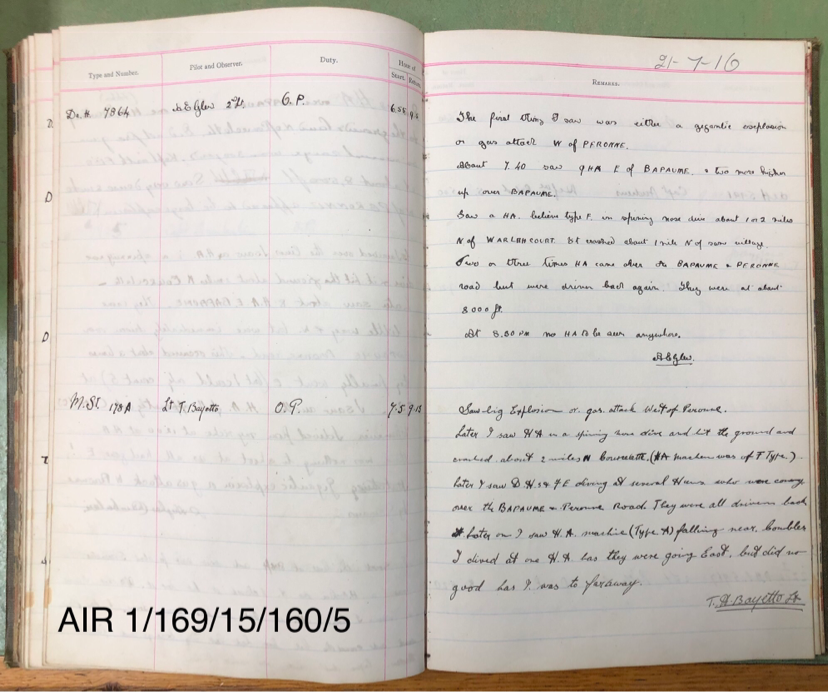
Test Flight 24 July 1916
Tone carried out a test flight in Morane A178. He “landed in no 3 aerodrome for a slight alteration in the rigging”

No.1 Reserve Squadron
Tone transfered to No.1 Reserve Squadron at Fort Grange, Gosport, UK, where a number of photos were taken of him in Morane Saulnier N A186. [service record card:AIR/76/29].

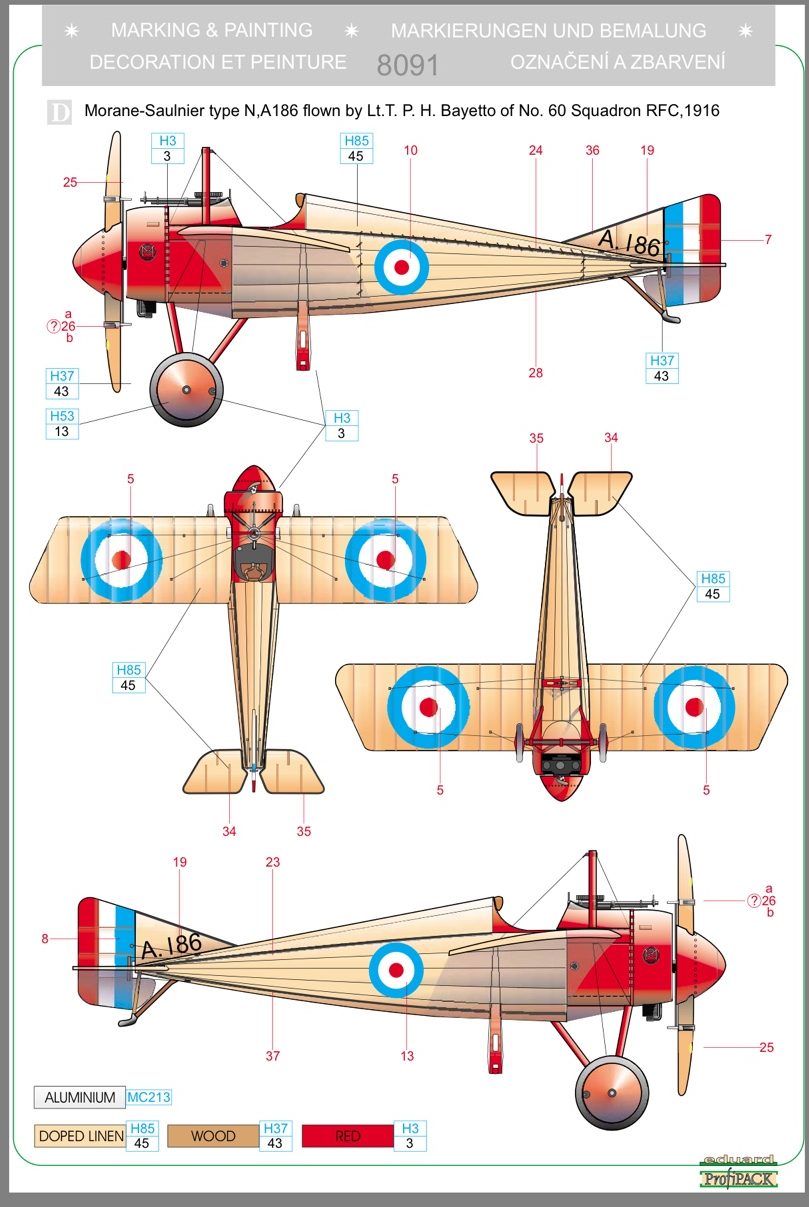





the reference to PS Joyce crashing A186 may be wrong because elsewhere:
“03 Sep 1916, 2nd Lt P S Joyce, 60 RFC, Morane A198, AGO CII, crashed”
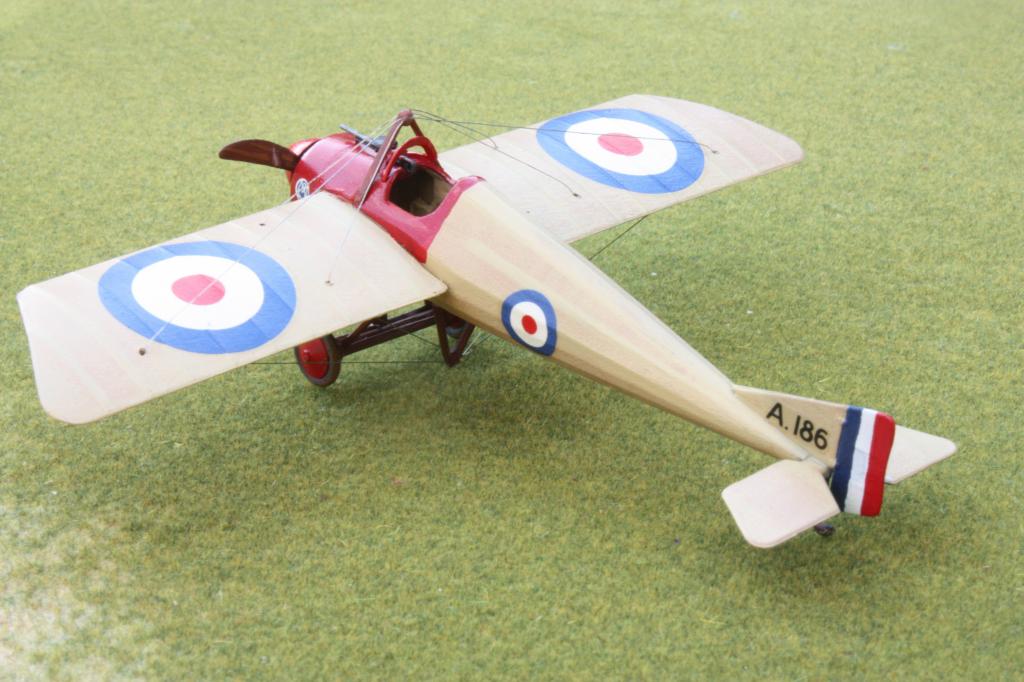


Tone Fighting Instructor at 17 Wing
Toné was at 17 Wing (was RFC Training Wing) as fighting instructor. (service record card:AIR/76/29)
Central Flying School
Tone at Central Flying School as fighting instructor (it was established in 1912 and located at RAF Upavon, Wiltshire).
(service record card:AIR/76/29)
Tone at 17 Wing
Tone at 17 Wing (was RFC Training Wing) as fighting instructor.
(service record card:AIR/76/29)
Southern Group Headquarters
Tone at (?) Southern Group Headquarters as fighting instructor.
(service record card:AIR/76/29)
Promotion to Flight Commander
Tone was promoted from (temp 2nd Lieutenant) Flight Officer to Flight Commander (& temporary captain) along with J B McCudden [Service record card; London Gazette 1/6/17]

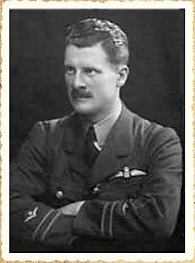

from Christophe Fran
Tone Presented with a Conductor’s Baton
Tone was presented with a silver topped inscribed conductor’s baton by members of the Central Flying School orchestra
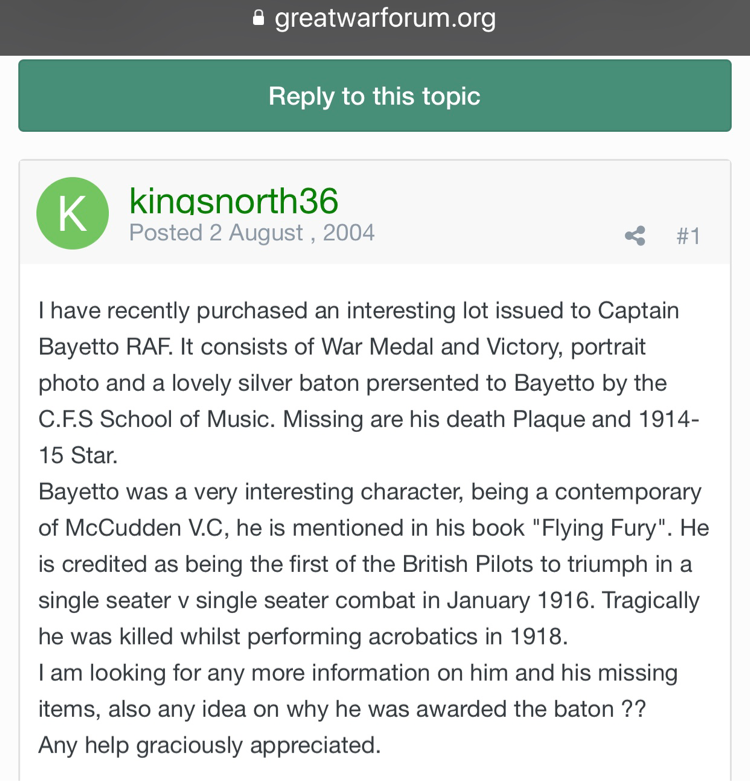
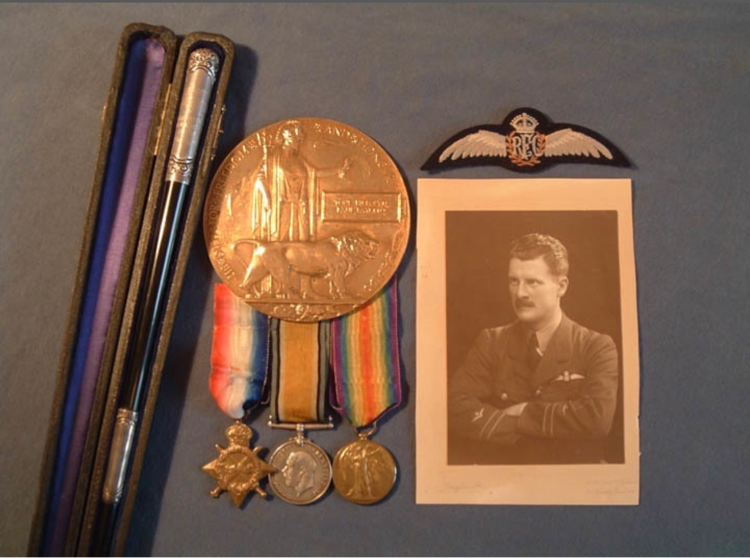
Tone Writes a Will

Tone Joins No.66 Squadron
Tone joined No. 66 Squadron as Flight Commander whilst it was based in Estrees-Blanche near Aire / Liettres France, under the command of GLP Henderson MC, and heavily engaged in the battle of Ypres flying Sopwith Pups [REFS: 66 FS biog; CROSS & COCKADE INT.1995;26(4):191-196; service record card:AIR/76/29]

Patrol 20 September 1917
Tone in B1760 led a patrol comprising HK Boyson, WA Pritt, LB May, DM Paton & WH Kelly [66FS bio, AIR 1/1778/204/148/20]
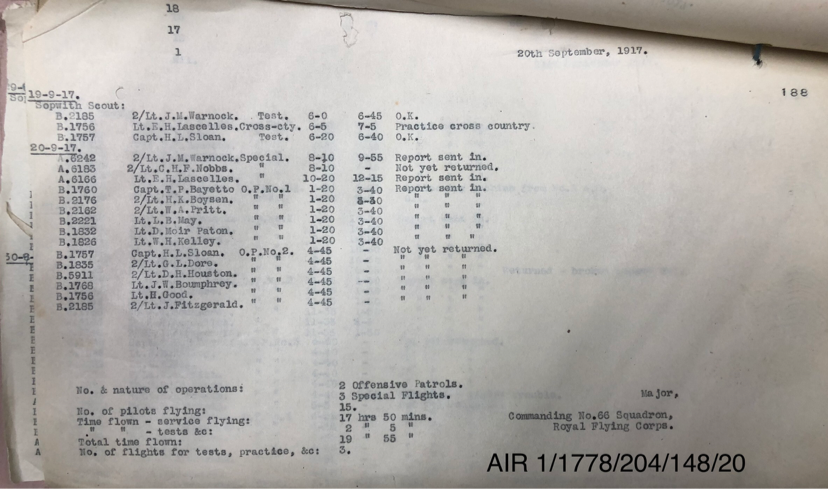
Patrol 21 Sept 1917
Tone in B1760 led a patrol comprising HK Boyson, WA Pritt, LB May, DM Paton & WH Kelly. Boyson had engine trouble and so returned to collect another machine (REF: 66FS bio)
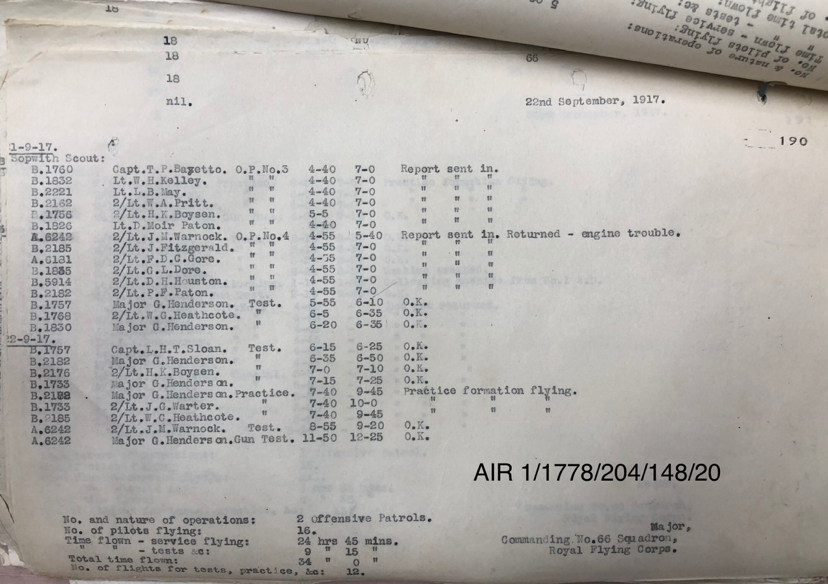
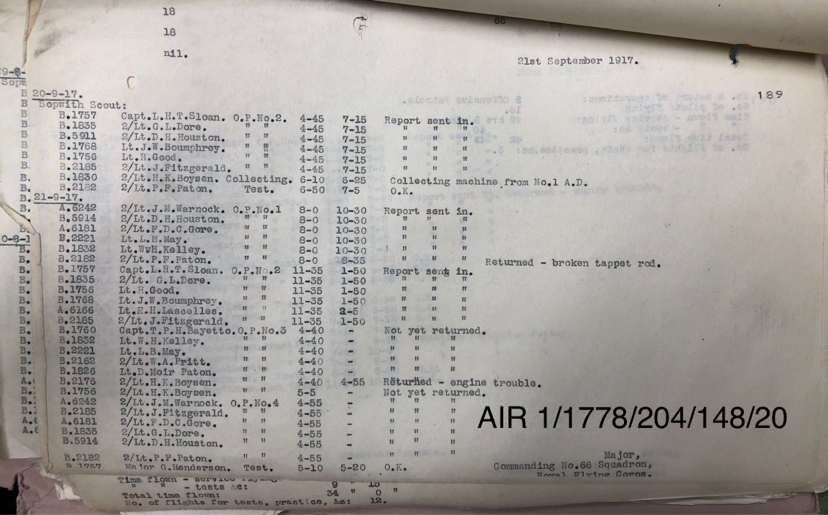
Crash, 23 Sept 1917
Tone crashed while test flying Pup B1760. This was Lt TV Hunter’s regular plane. [AIR 1/1778/204/148/20, 66FS bio]


Morning Patrol 24 September 1917
Tone in B1756 led an uneventful early morning patrol of six Sopwith Scout at Abeelhoek [AIR 1/1778/204/148/20]

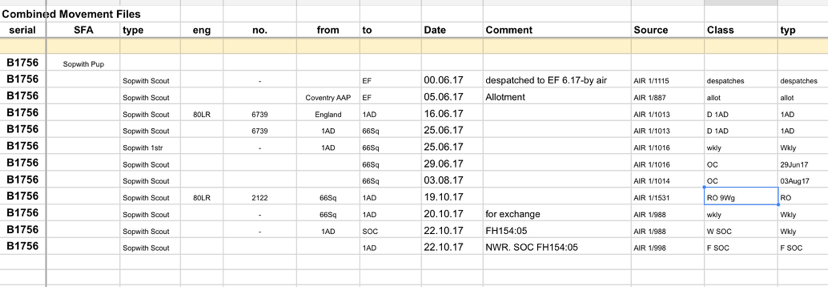
D M Patton KIA 24 September 1917
Tone in B1756 led a mid afternoon patrol with six Sopwith Scouts at Roulers-Abeele during which DM Paton was shot down and killed in Sopwith Scout B1826 [REF: AIR 1/1778/204/148/20, 66FS bio]
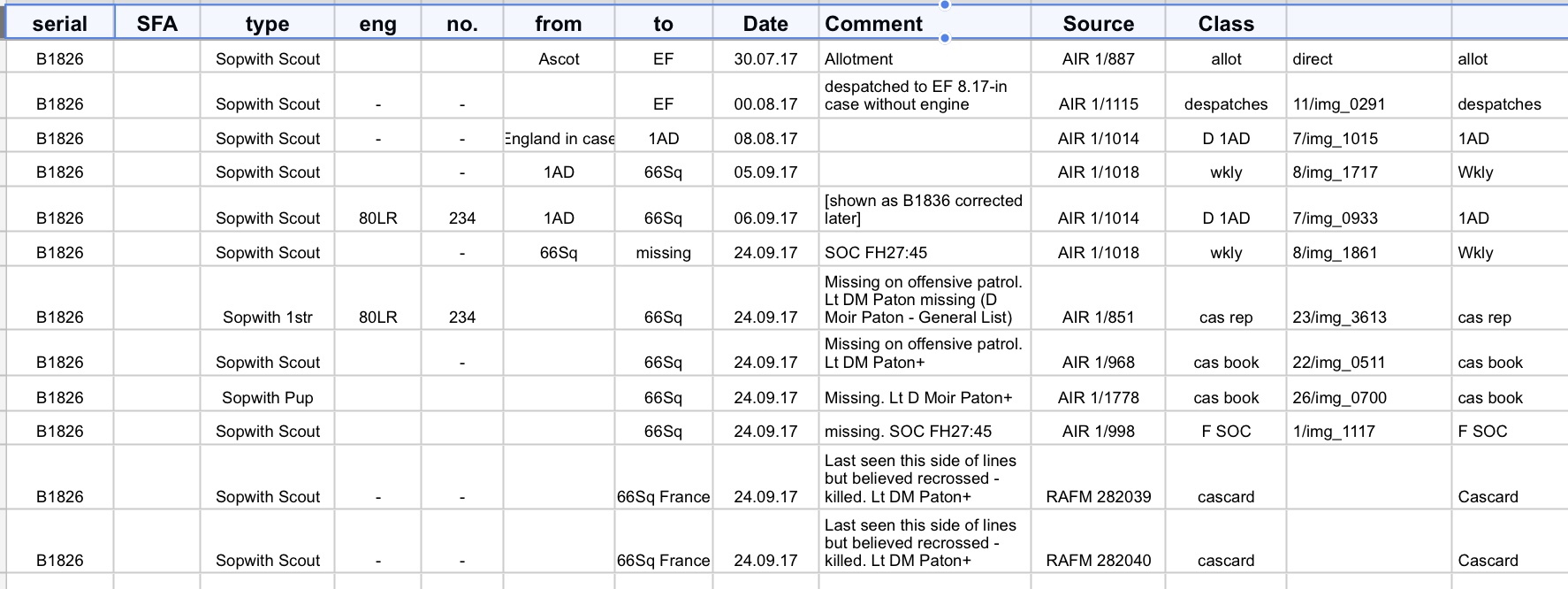
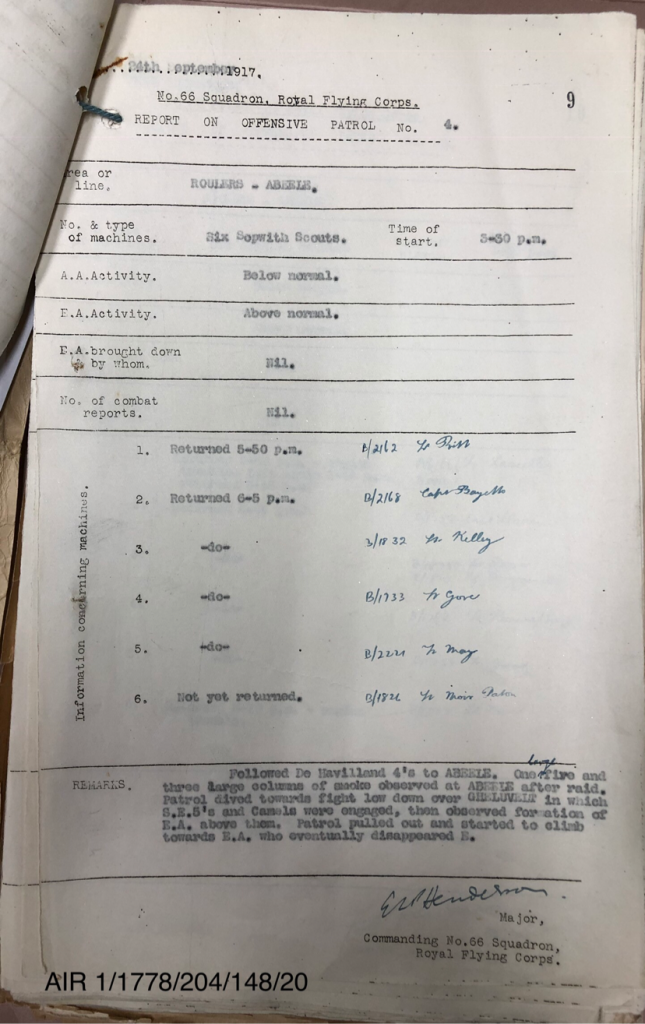
Test Flight 25 September 1917
Tone completed an early morning test flight in Sopwith Scout B2168 [AIR 1/1778/204/148/20]
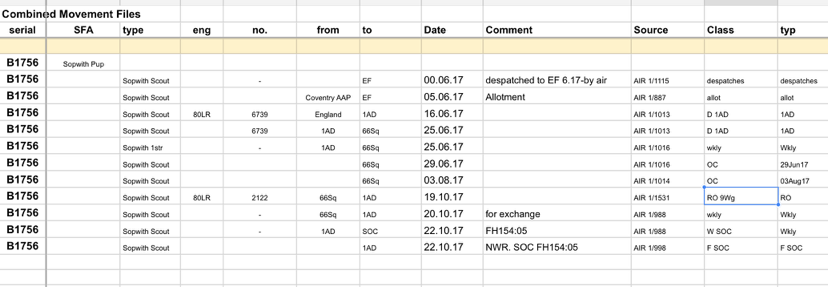
Patrol, 26 Sept 1917
Tone in B2168 led an uneventful patrol east of Ypres comprising Erskine, Boyson, Pitt, Dore & May [REF: AIR 1/1778/204/148/20, 66FS bio]
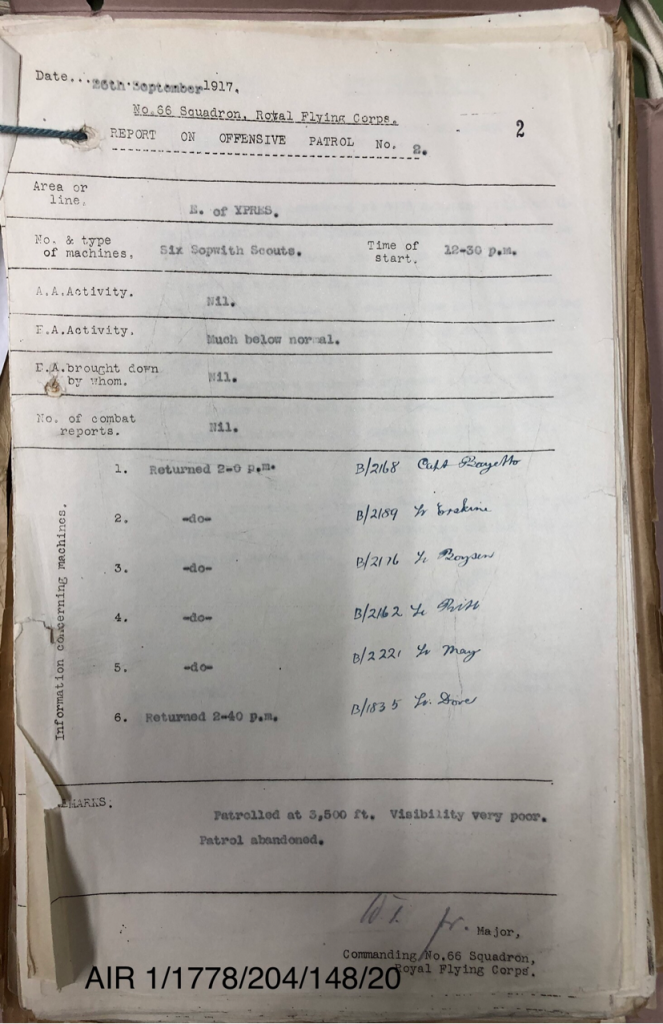
Practice Patrols 29 September 1917
Tone in B2168 led two early morning practice patrols of 6 Sopwith Scouts, practising formation flying [AIR 1/1778/204/148/20]
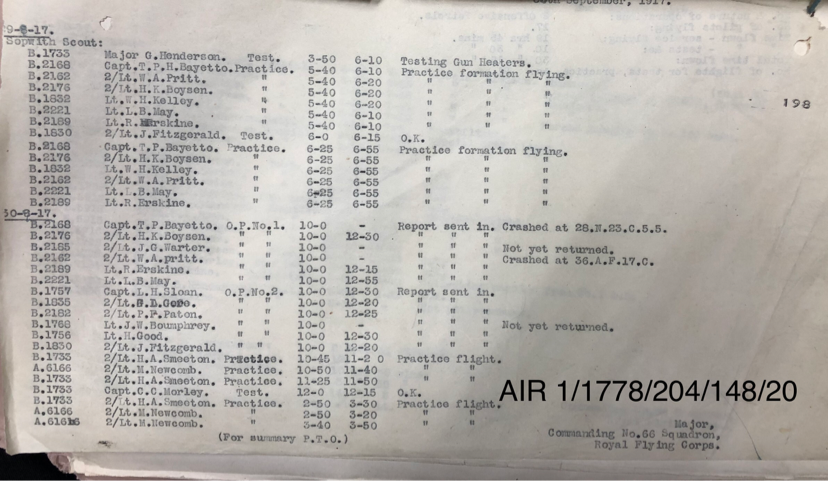
Tone ‘kill 4’ & crash 30 September 1917
Tone was shot down and two of his patrol were killed in action. Tone took off at 10.00 in Sopwith Pup B2168 leading a patrol comprising 2/Lt Joseph G Warter in B2185; James W Boumphrey in B1768; Howard K Boyson in B2176; Ralph Erskine in B3189; Lamcelot May in B2221 & Walbanke A Pritt in B2162. The patrol was engaged by 15 enemy aircraft [1] from above near the Menin-Roulers road, one of the enemy aircraft. positioned behind Bayetto, but he was able to evade the attack, he then closed on another enemy aircraft who was on the tail of one of the patrol Pups, Bayetto was unable to fire on this enemy aircraft and it shot down the Pup in flames this was either Warter who was killed in the action or Pritt who crashed near the lines. Tone then saw another Pup with two e.a. on its tail; diving towards the group he closed to within 30 feet and fired on the enemy. He watched the tracer entering the fuselage just behind the pilot, who looked over and saw Bayetto and then slumped over the side of the cockpit. The e.a. machine started to descend & signs of smoke were observed. Tone levelled out at 8000 feet, hearing machine guns He looked around to find another e.a. diving on him. Tone performed an ‘Immellman’ [see picture] getting behind the enemy aircraft he fired a short burst into the machine; the propeller was seen to stop and the e.a. started to make for the east. At the same time a two seater opened fire on Toné from underneath the Pup shooting away one of his cylinders and tearing away his cowling, piercing his petrol tank and shooting two blades off his propeller. He was then attacked by another Albatross Who shot him up his left rear spar which resulted in the spar and several wing ribs breaking. In one of his accounts of the action Tone says that the patrol was attacked by 26 enemy machines; that he was shot about and flew the aeroplane upside down and attempted to right the craft shortly before landing. In another account he pancaked the machine from 20 feet in amongst shell holes and as he crashed, Tone’s face hit the windscreen and Lewis gun butt; the fuselage compressed the cockpit; the undercarriage collapsed and the machine turned over on its nose. It took about 20 minutes for him to be rescued. He sustained impact wounds to his face and back. He bled from his ears nose and mouth. He was unconscious for a while and was later found to be suffering from a fractured base of skull. He was sent back down the lines and admitted to No.7 General Hospital, St Omer. B2168 was salvaged and sent to 1 Aircraft Depot for repair. [66FS bio]
[1] The patrol was engaged by Jasta 18 who claimed three: Toné plus 2Lt J.C. Warter and Lt J.W. Bumphrey who were both reported KIA. [CROSS & COCKADE INT.1995;26(4):191-196]
“A patrol of 66 squadron were pursuing a hostile two-seater when they were dived upon by an EA formation. The pilots, though at a disadvantage, fought well and one EA was destroyed by Captain Bayetto, while another was driven out of control by Lt W A Pritt. Two of our machines were lost on the other side and two were forced to land on our side, while other machines were much shot about, one coming back with a cylinder completely shattered.”
Royal Flying Corps Communiques 1917 1918





Tone repatriation
18 Oct 1917. Tone repatriated to home establishment via Calais and Dover. [WO 339/56618]
Royal Free Hospital
19 Oct 1017. Tone admitted to Royal Free Hospital, Grays Inn Road [WO 339/56618]
Medical Board, 14 Nov 1917
Medical Board Examination at Caxton Hall SW. – likely to be incapacitated for 3 1/2 months. At this point he was staying at Endasleigh Palace Hospital, 25 Gordon Street, London- [WO 339/56618]



Mrs Mulliner’s Hospital
24 Nov 1917. Tone admitted to Mrs Mulliner’s Hospital at Clifton Court, Rugby. Colonel & Mrs Mulliner had given up their residence to the War Office, as a V.A.D. Hospital for the benefit of wounded R.F.C. Officers. [WO 339/56618]



Requests Wound Gratuity
12 Dec 1017. Tone writes to the War Office from Mrs Mulliner’s Hospital describing the plane crash and requesting a “wound gratuity” [WO 339/56618]

Medical Board, 16 Jan
Medical Board Examination. “Concussion and fracture base of skull (?) Is making satisfactory progress..The headaches have almost disappeared, he sleeps well and is free from the haunting dreams which troubled him. His memory is better. There is some nervous irritability……100% disabled…(not fit for any form of service) convalescent at Clifton Court, Rugby”. [WO 339/56618]


Medical Board, 23 Feb
Medical Board Examination, 1st Southern General Hospital, Edgbaston, Birmingham. Granted three weeks leave and told to write forthwith reporting for duty. [WO 339/56618]


Letter to Ye Olde Roses
8 Mar 1918. Letter to Tone at Ye Olde Roses, Lime Grove, Eastcote directing him to appear before the Royal Flying Corps Officers’ Invaliding Board on 19 March. [WO 339/56618]
Posted to No.1 Training Squadron
Precise date unclear but around this time Toné was posted to No. 1 Training Squadron based at Beaulieu Airfield, East Boldre. [AIR/76/29].
Note: No. 1 TS having relocated to East Boldre from Port Meadow, Oxford on 16th December 1917 and remained there until being disbanded and absorbed into No. 29 Training Depot Station on 27th July 1918 [http://www.eastboldre.org/airfieldhistoryww1.html].


Transfer to No.70 Training Squadron
41 March 1018. Tone transferred to No. 70 Training Squadron which was also located at Beaulieu Aerodrome, East Boldre. “Fit…No flying” [AIR/76/29].
Note: 70 TS had moved to Beaulieu from Gosport on 1 January 1818 and remained there until 27th July 1918 when it relocated to Weston-on-the-Green. [http://www.eastboldre.org/airfieldhistoryww1.html]
Medical Board, 17 April
Final Medical Board examination in Hampstead. Noted: “He has absolutely recovered. Fit in every way. No headaches, sleeping well …. very keen to fly again.” Considered fit for light duty flying duties. Flying pay resumed. [WO 339/56618]


Death of James McCudden
9 July 1918. Death of James McCudden VC during a flying accident [Flying Fury Pxiii]

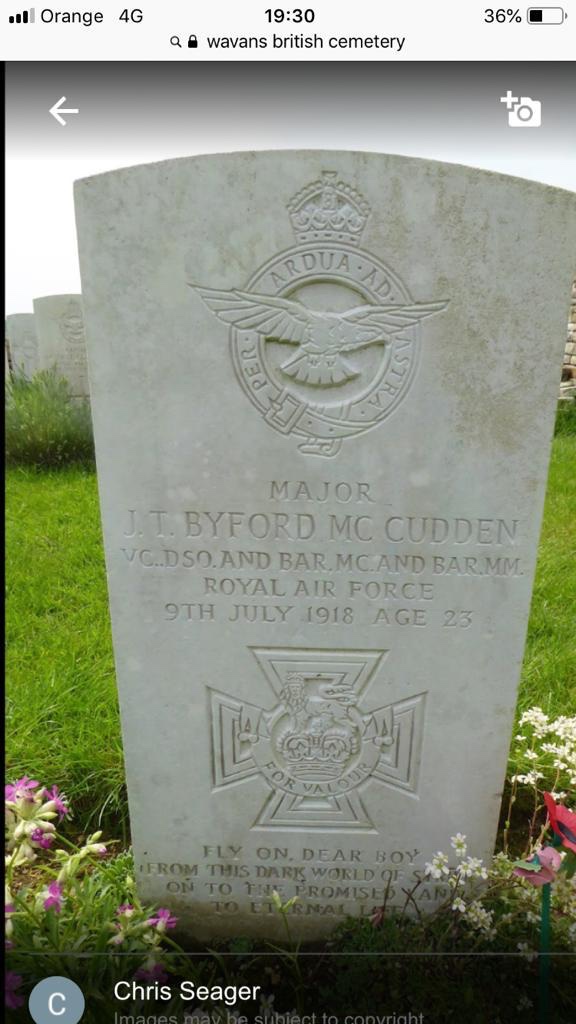
Transfer to 29 Training Depot Station
Tone’s final transfer was to the newly formed No. 29 Training Depot Station which was also located at East Boldre. [No. 29 TDS was formed on on 27th July 1918 when No. 1 TS and No. 73 TS, which had arrived at East Boldre from Turnhouse on 20th February 1918, were merged – http://www.eastboldre.org/airfieldhistoryww1.html].
Tone Bayetto RIP
28 July 1918. Tone died following a crash while flying Sopwith Dolphin III E4449 (with 200HS engine) at Beaulieu Airfield, East Boldre.
“One wing folded at 2000ft during aerobatics exhibition and dived straight into ground. Capt TPH Bayetto killed.“ [RAFM 264819].
He flew a bright red Sopwith Dolphin which had all its flying and landing wires specially tensioned for aerobatics. He was in the habit of flying over to his girl friend’s house for tea every Sunday and one evening on his return he enjoyed his usual stunting over our Airfield before coming in. It was a sickening experience to see one of his lower wings fold up whilst he was performing a flick roll, the aircraft crashing from about 1500 feet. He was a wonderful person and admired by the whole Squadron. I and another great friend of his named Storrs were pall-bearers and took his body to the train at Brockenhurst. [Personal account by Flight Cadet Eric Foster p154 From Forest Field to Western Front].



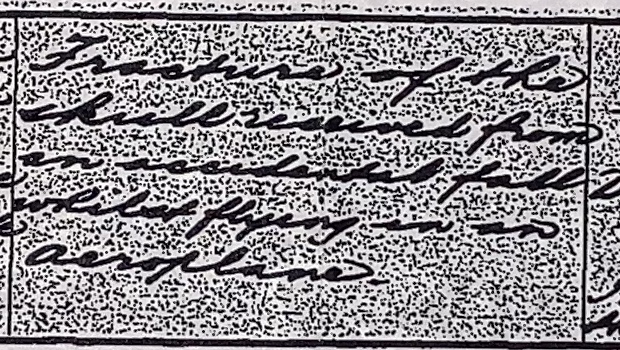




Obituary, The Aeroplane
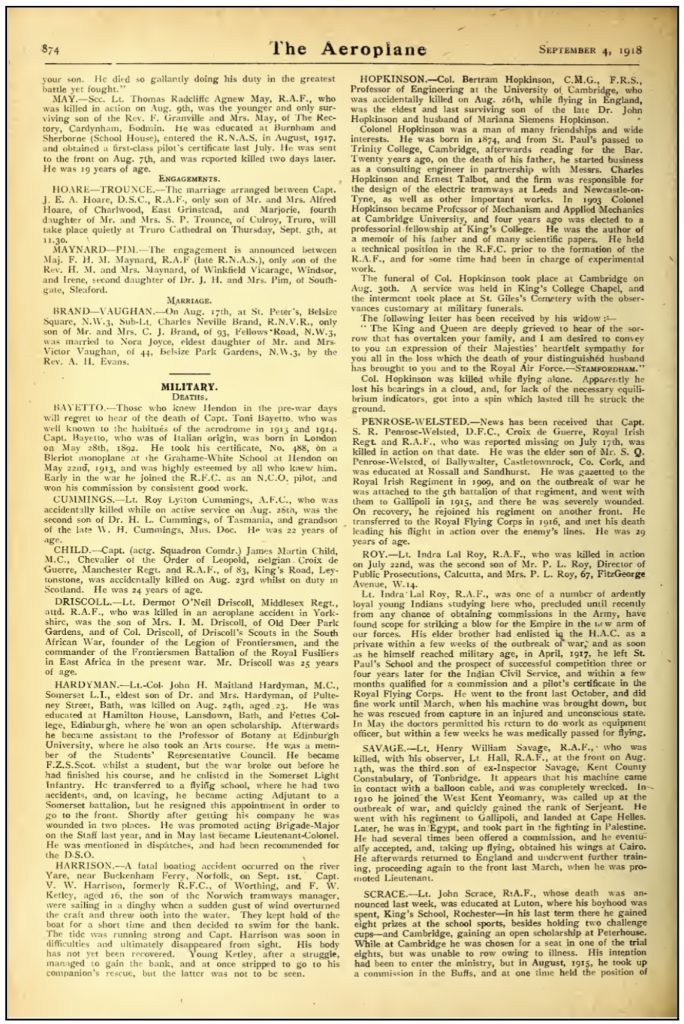
Tone buried in Ruislip
Tone is buried in the churchyard extension of St Martins Church with his father Hippolyte who died on 18 December 1930.




Eastcote WW1 Memorial

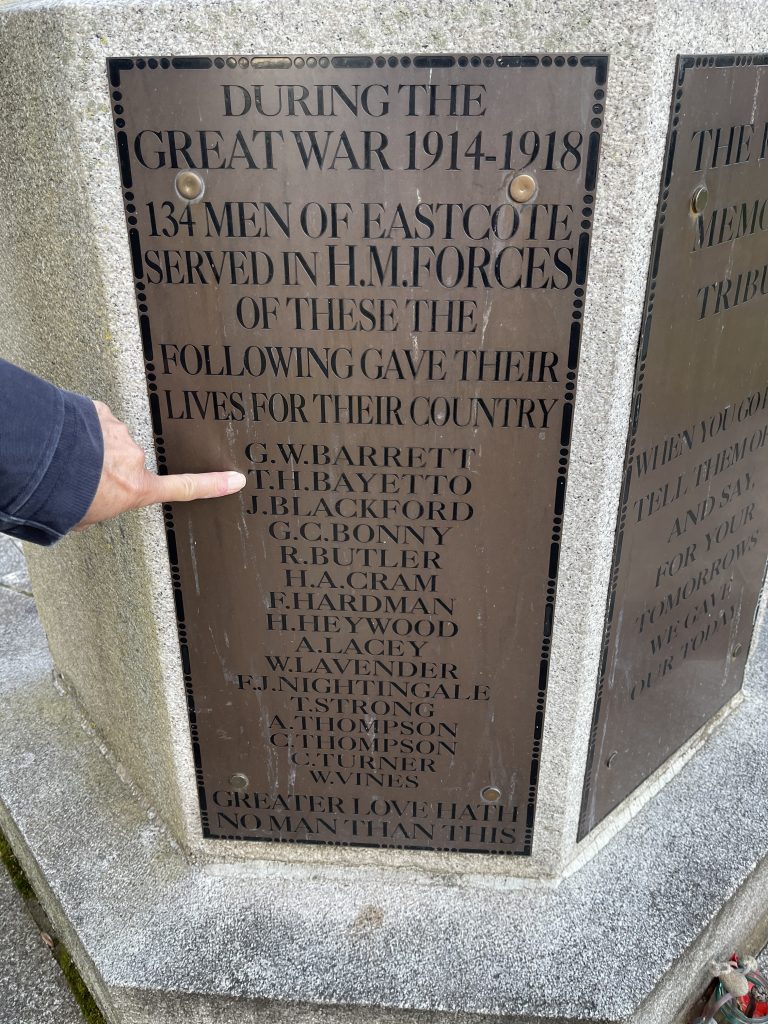
Death of Hippolyte
18 Dec 1930. Death of Hippolyte Paul Bayetto, aged 66y. Buried with his son.

“I had a friend, Wing Commander Willie Fry, who knew Lt T P H Bayetto. Willie gave me the information which I used in a caption for a photograph of your great uncle in an old booklet of mine: British Fighter Units Western Front 1914-1916 which was published by Osprey in 1978. If you go on the web I think you’ll find there are still copies avaliable. The caption reads: ‘A popular officer in the RFC was Lt. T.P.H Bayetto… Bayetto’s father was head chef at one of London’s leading hotels and was always happy to give any RFC friends of his son a good meal free of charge’“. Alex Revell
Death of Rosalie
15 Feb 1957. Death of Rosalie Bayetto aged 90y
